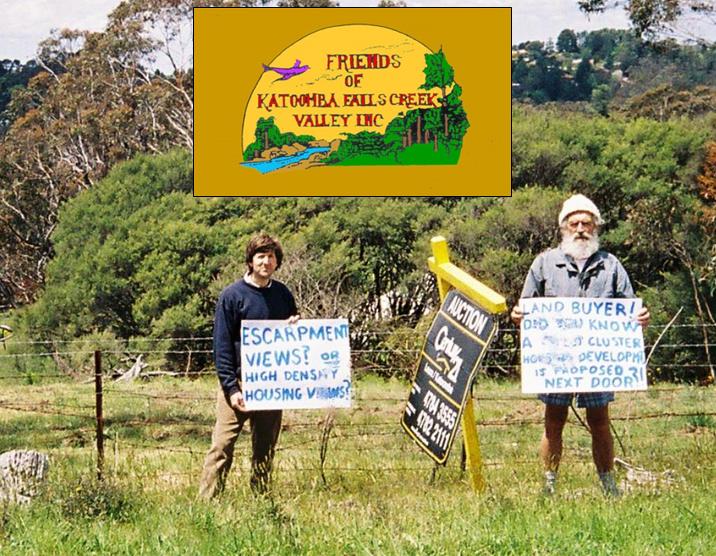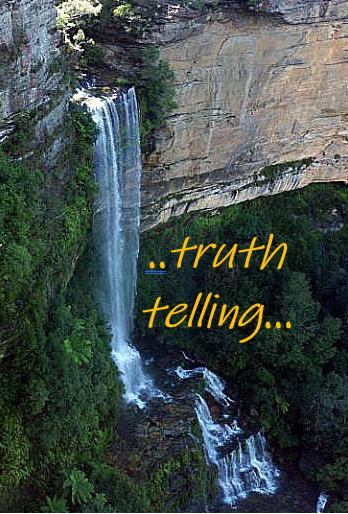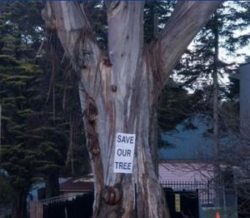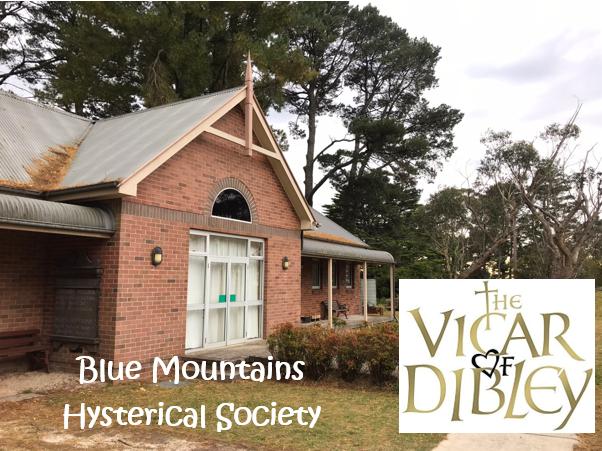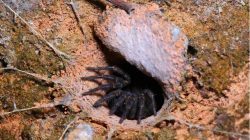Author Archive
Friday, February 24th, 2012
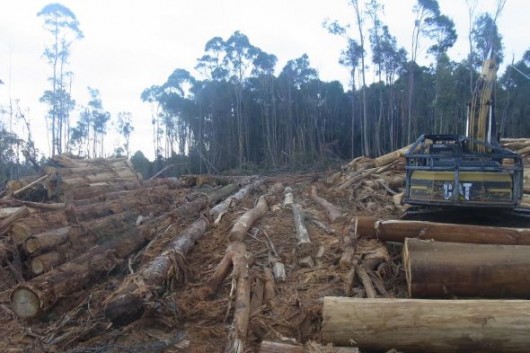 Tasmania’s Old Growth Forests
– victims of obsessive compulsive logging by Forestry Tasmania
(Photo courtesy of HVEC and Code Green) Tasmania’s Old Growth Forests
– victims of obsessive compulsive logging by Forestry Tasmania
(Photo courtesy of HVEC and Code Green)
.
Logging is not about woodchips or timber or even land clearing for plantations. It is a compulsive addiction, like compulsive hoarding.

Compulsive Logging Self Test:
Are you a compulsive logger? Answer YES or NO to the following:
.
- Do you find yourself logging forests that timber markets do not consider valuable?
- Do you experience difficulty or find it impossible to stop logging say for more than a week?
- Do you keep your chainsaw in your ute?
- When you drive past a forest, or even a tree for that matter, do you get an urge to chainsaw it?
- Do you need to be told to stop chainsawing at the end of a day’s shift, even after it has become dark?
- Do you have recurring dreams about falling trees?
- Do you hate Monty Python’s I’m a Lumberkjack song, and become agitated and violent when hearing it played?
.
If you answered YES to most of the above questions, you maybe a compulsive logger.
.
Forestry Tasmania a Compulsive Logger
.
Despite Tasmania’s Inter-governmental Agreement (IGA) on 7th August 2011 assuring immediate logging moratorium of native forests in agreed reserves, Forestry Tasmania continues to eco-rape and pillage protected native forests in defiance of this agreement.
.
IGA Clause 25 states:
‘The State will immediately place the 430,000 hectares of native forest identified in Attachment A (other than any areas that are not State forest), from the 572,000 hectares nominated by ENGOs through the Statement of Principles process, into Informal Reserves. The boundaries of this 430,000 hectares were verified through an independent verification process.’
.
Yet the Tasmanian Government’s industrial logger Forestry Tasmania displays business as usual pre-IGA (7-Aug-2011) and pre-Conservation Agreement (13-Jan-2012).
Forestry Tasmania is delinquent, operating to its own parallel agenda, despite being taxpaper funded, despite annually losing millions of taxpayer funding. It is an indulgent selfish cult offering only hand to mouth welfare to its logging members. It is currently getting stuck into Coupe BA388D in the Liffey State Forest inside the IGA Immediate Protection Area of 430,000 hectares.
.
Forestry Tasmania is characterised by the following:
-
- Feelings of excessive doubt and caution
- Preoccupation with details, rules, lists, order, organization or schedule
- Excessive conscientiousness, scrupulousness, and undue preoccupation with productivity to the exclusion of pleasure and interpersonal relationships
- Excessive pedantry and adherence to social conventions
- Rigidity and stubbornness
- Unreasonable insistence that others submit exactly to its way of doing things, or unreasonable reluctance to allow others to do things
- Intrusion of insistent and unwelcome thoughts or impulses.
Tasmanian Forests Minister Bryan Green dodges questions, covering for Forestry Tasmania
.
‘The Tasmanian Greens today accused the Minister for Forests Bryan Green MP of dodging questions on whether Forestry Tasmania has entered into any new wood supply contracts since the implementation of the moratorium on logging high conservation value forests.
Greens Forestry spokesperson Kim Booth MP said that in Parliament today the Minister would only say that Forestry Tasmania had renewed contracts with sawmills, but did not clarify whether the duration and/or volume of those contracts had been changed.
“I have asked Minister Green on numerous occasions to provide details of any contracts Forestry Tasmania has signed for logging or roading in high conservation value forests placed under a moratorium by the Forest Principles process,” Mr Booth said.
“Judging by the Minister’s refusal to answer my clear and direct question it would appear he is trying to cover for Forestry Tasmania’s refusal to comply with the IGA.”
“The Minister must clarify whether Forestry Tasmania is deliberately undermining the Tasmanian Forests Intergovernmental Agreement and all the hard work that has gone into it.”
“Forestry Tasmania is stuck in the past and continues to want to wage war over the Tasmanian forests by targeting areas of High Conservation Value forests.”
“The Minister for Forests must once and for all clarify what he knows about any contracts that have been signed or renewed since the moratorium was put in place.”
“I will be writing to the Minister for a full and detailed response to the question that I asked in Parliament today and I would urge him to encourage Forestry Tasmania to keep up with the expectations of Tasmanians and play their part in the implementation of the IGA.”
November 16, 2011
[Source: ^http://mps.tas.greens.org.au/2011/11/minister-dodges-questions-covering-for-forestry-tasmania/]
.
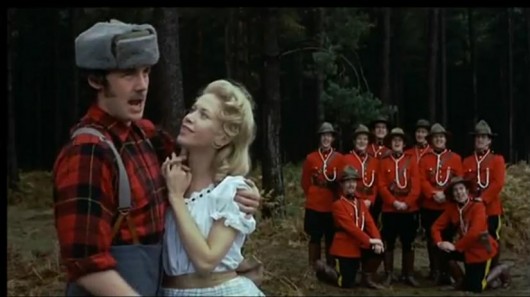

.
I’m a Lumberjack
(Tasmanian version)
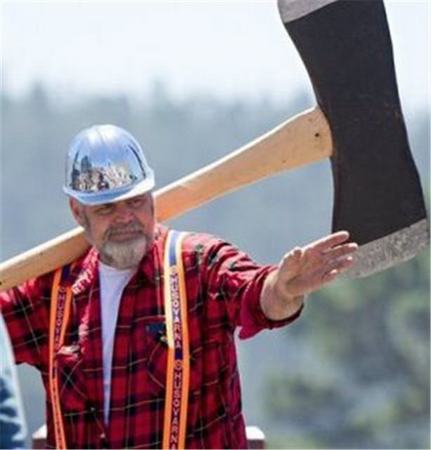
He’s a logger and he’s okay, he borrows for gear ‘cos Gillard ‘ll pay.
.
FORESTRY TAS:
He’s a logger, and he’s okay.
He borrows for gear cos Gillard will pay.
.
LOGGER:
I cut down trees. I eat my lunch.
I go to the lavatory.
On Fridays afters, I knock off
And call into the National for tea.
.
FORESTRY TAS:
He cuts down trees. He eats his lunch.
He goes to the lavatory.
On Fridays afters, I knock off
And call into the National for tea.
He’s a logger, and he’s okay.
He sleeps all night and he works all day.
.
LOGGER:
I cut down trees. I skip and jump.
I like to press wild flowers.
I put on women’s clothing
And hang around in bars.
.
FORESTRY TAS:
He cuts down trees. He skips and jumps.
He likes to press wild flowers.
He puts on women’s clothing
And hangs around in bars?!
He’s a lumberjack, and he’s okay.
He sleeps all night and he works all day.
.
LOGGER:
I cut down trees. I wear high heels,
Suspendies, and a bra.
I wish I’d been a girlie,
Just like my dear Papa.
.
FORESTRY TAS:
He cuts down trees. He wears high heels,
Suspendies, and a bra?!
?????
What’s this? Wants to be a girlie?! Oh, My!
…X%$*&#@)*#!^@!
He’s a lumberjack, and he’s okay.
He sleeps all night and he works all day.
He’s a lumberjack, and he’s okaaaaay.
He sleeps all night and he works all day.
.
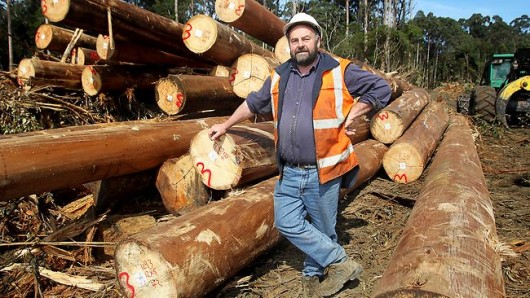 . .
‘An audit of Forestry Tasmania’s logging plans by environment groups shows Forestry Tasmania has not only failed to cease logging within proposed new forest reserves, but since receiving a $12.5 million government payout, it has increased the number of logging operations within the new reserve areas — a move directly at odds with the Tasmanian Forests Intergovernmental Agreement (IGA).’
~ 9th February 2012
.
[Source: ‘Forestry Tasmania’s ongoing logging in proposed new forest reserves‘, joint publication by The Wilderness Society, Environment Tasmania, and the Australian Conservation Foundation, ^http://www.wilderness.org.au/pdf/ongoing-logging-report >Read Report (pdf) ]
.
Thursday, February 23rd, 2012
The following article is a press release by UK-based NGO, The Environmental Investigation Agency (EIA), of 20120124 entitled ‘Conservation on the Front Line – Muara Tae’s Last Stand Against Big Palm Oil’
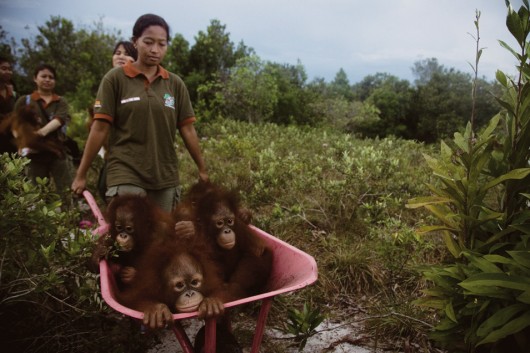 Their ancient rainforest home clearfelled for bloody Palm Oil,
now these Orang-utans are homeless in their own homeland
[Source: ^http://www.pdnphotooftheday.com/2010/05/4673]
(Click photo to enlarge) Their ancient rainforest home clearfelled for bloody Palm Oil,
now these Orang-utans are homeless in their own homeland
[Source: ^http://www.pdnphotooftheday.com/2010/05/4673]
(Click photo to enlarge)
.
MUARA TAE, EAST KALIMANTAN (Borneo, Indonesia):
The fate of a Dayak indigenous community, deep in the interior of East Kalimantan (Borneo) demonstrates how Indonesia must safeguard the rights of indigenous people if it is to meet ambitious targets to reduce emissions from deforestation.
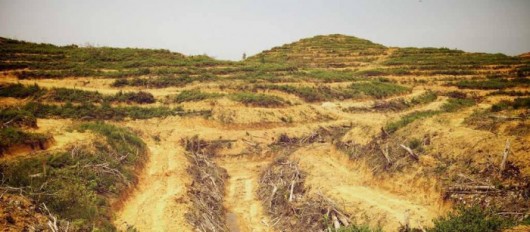 Cleared land at Muara Tae
(c) EIA/Telapak Cleared land at Muara Tae
(c) EIA/Telapak
.
The Dayak Benuaq of Muara Tae, in West Kutai Kabupaten (Indonesia), today face a two-pronged assault from palm oil companies aggressively expanding into their ancestral forests. Together with Indonesian NGO Telapak, the community is manning a forest outpost around the clock in a last ditch attempt to save it from destruction.
The London-based Environmental Investigation Agency (EIA) has witnessed at first-hand the Dayak Benuaq’s struggle, and how their sustainable use of forests could help Indonesia deliver on its ambitious targets to reduce greenhouse gas emissions.
EIA Forests Team Leader Faith Doherty said: “There are more than 800 families in Muara Tae relying on the forests for their food, water, medicine, culture and identity. Put simply, they have to keep this forest in order to survive.
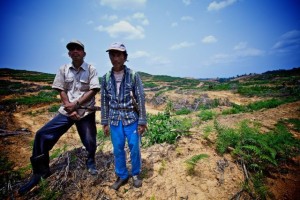 Villagers on cleared land at Muara Tae
(c) EIA/Telapak Villagers on cleared land at Muara Tae
(c) EIA/Telapak
.
“The rhetoric from the President of Indonesia on curbing emissions by reducing deforestation is strong but on the front line, where indigenous communities are putting their lives at risk to protect forests, action is sorely missing.
“Giving these communities, such as the Dayak Benuaq, the rights they deserve is a vital step to reduce catastrophic levels of deforestation in Indonesia.”
President Yudhoyono has pledged to reduce carbon emissions across the archipelago by 26 per cent by 2020 against a business-as-usual baseline, alongside delivering substantial economic growth.
 Self-serving bullshit artist
– take your pick Self-serving bullshit artist
– take your pick
.
Plantation expansion will inevitably be a significant element of growth, but it has historically been a major driver of emissions and it is widely acknowledged that in order avoid them, expansion must now be directed to ‘degraded’ lands.
As a result of weak spatial planning, however, the forests of Muara Tae are identified as ‘APL’, a designation meaning they are not part of the national forest area and are open to exploitation. The theft of indigenous forests also raises serious questions as to what form of ‘development’ these plantations offer.
In indigenous communities such as the Dayak Benuaq of Muara Tae, Indonesia has perhaps its most valuable forest resource. It is due to their sustainable methods, honed over generations, that the forest even remains.
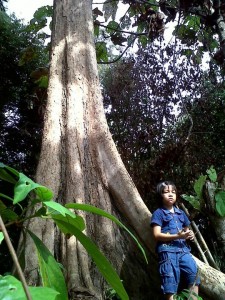 Benuaq girl and ncap payang tree
(c) EIA/Telapak Benuaq girl and ncap payang tree
(c) EIA/Telapak
.
Telapak president Ambrosius Ruwindrijarto said:
“Together with the community, we have not only been protecting the last forests but also planting new Ulin and Meranti saplings to enhance it. These people are the true guardians of the forest and their fate is entwined with it.”
Muara Tae has lost more than half of its land and forests during the past 20 years to mining companies. The impact has been tangible; the villagers’ water source has dried up and they must now routinely make a 1km journey to collect clean water.
The remaining forest is home to a large number of bird species including hornbills, the emblem of Borneo. There are about 20 species of reptiles and it is also a habitat for both proboscis monkeys and honey bears.
 Indonesia’s Environment Minister Gusti Hatta,
all talk..so…’what does an Orang-Utan look like?‘
. Indonesia’s Environment Minister Gusti Hatta,
all talk..so…’what does an Orang-Utan look like?‘
.
The latest land-grabs have taken place since January 2010, when the local Bupati (regional government official), Ismail Thomas, issued plantation permits to two palm oil companies: Malaysian-owned PT Munte Waniq Jaya Perkasa (PT MWJP) and PT Borneo Surya Mining Jaya, a subsidiary of Sumatran logging, mining and plantation conglomerate Surya Dumai.
While the Norwegian Government has been instrumental in financially backing efforts to reduce deforestation in Indonesia through the REDD+ initiative, it has also invested in the parent company of PT MWJP through its sovereign wealth fund.
Pak Singko, a leader of the Dayak Benuaq of Muara Tae, said: “We are calling for help from people everywhere in protecting our forests and ancestral land. We are being squeezed from all sides by mining and plantation companies.
.
“This is the last remaining forests that we have and the only land we have to survive.
If my forests are gone, our lives will end.”
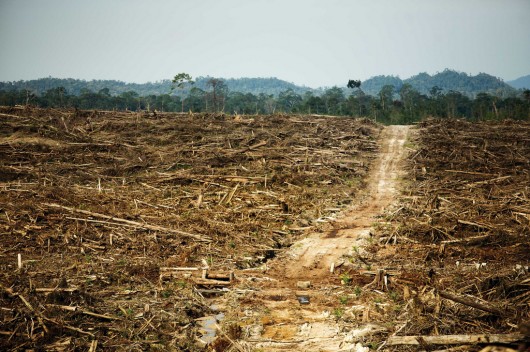 Cargill’s ecological facism for its self-serving Palm Oil
The destruction of primary rainforest by Duta Palma. West Kalimantan, Borneo.
Cargill was a key purchaser of palm oil from this notorious rainforest destroyer up until 2008. Cargill’s ecological facism for its self-serving Palm Oil
The destruction of primary rainforest by Duta Palma. West Kalimantan, Borneo.
Cargill was a key purchaser of palm oil from this notorious rainforest destroyer up until 2008.
[Source: Photo: David Gilbert/RAN, ^http://www.flickr.com/photos/rainforestactionnetwork/5551935164/]
(Click photo to enlarge)
.
The above photo is from an investigative report from Rainforest Action Network that presents evidence that (US conglomerate) Cargill is operating two undisclosed palm oil plantations in West Kalimantan, Indonesia.
 Cargill’s pathetic claim of its Corporate Responsibility in Indonesia Cargill’s pathetic claim of its Corporate Responsibility in Indonesia
[Source: Cargill corporate website: ^http://www.cargill.com.au/en/index.jsp].
.
When William Wallace Cargill founded our company in 1865, he deliberately set out to ensure that we earned and maintained a reputation for integrity, which he saw as a key differentiator in those times.
Corporate responsibility is part of everything we do. It is a company-wide commitment to apply our global knowledge and experience to help meet complex economic, environmental and social challenges wherever we do business. It is a process of continually improving our standards, our actions and our processes. Corporate responsibility extends not only to our own operations but to our wider communities and is based on four commitments:
- We will conduct our business with high levels of integrity, accountability and responsibility.
- We will develop ways of reducing our environmental impact and help conserve natural resources.
- We will treat people with dignity and respect.
- We will invest in and engage with communities where we live and work.
We recognize our continued success depends on the growth and health of our communities and partners, as well as the vitality and conservation of our natural resources. We are working with a diverse group of global, national and local organizations to support responsible economic development, help protect the environment and improve communities.
 Forced eviction, forced immigration
Orang-Utan orphans fleeing their ravaged parents and their ravaged ancestral homes
Forced eviction, forced immigration
Orang-Utan orphans fleeing their ravaged parents and their ravaged ancestral homes
Present us an American citizen accepting of such home eviction!
.
ED: Cargill’s eco-rape and eco-plunder policy across Indonesia’s vulnerable Borneo (Kalimantan) demonstrates that Cargill’s above public relations spiel is clearly crap! This is a wealthy United States corporate exploiting a poor country’s precious rainforest ecosystems, buggering local indigenous peoples and driving the extinction of the endangered Orang-Utan. If you work for Cargill or have shares in Cargill yoiu may as well be associated with the arms suppliers to the Syrian president Bashar al-Assad and his regime.
 Not just home invasion, but complete ecological erasion
Cargill is calling in the A-Bomb to Orang-Utans
What United States citizen would tolerate this?
911 is being inflicted on vulnerable species by the United States Not just home invasion, but complete ecological erasion
Cargill is calling in the A-Bomb to Orang-Utans
What United States citizen would tolerate this?
911 is being inflicted on vulnerable species by the United States
.
.
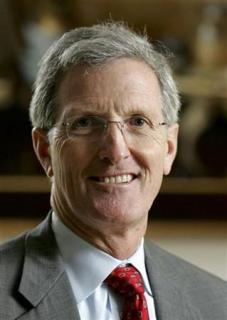 Cargill’s worldwide president and COO Gregory R. Page
His life won’t end in devastation, but he drives devastation in vulnerable Kalimantan – in secret! Cargill’s worldwide president and COO Gregory R. Page
His life won’t end in devastation, but he drives devastation in vulnerable Kalimantan – in secret!
.
Further Reading:
.
[1] ‘Villagers face off against palm oil firm’s bulldozers‘, by EIA, 20111123, ^http://www.eia-international.org/villagers-face-off-against-palm-oil-firms-bulldozers
.
[2] ‘Orangutan ‘killers’ on trial over slaughtering primates for pest control at palm oil plantation‘, by Damien Gayle, Daily Mail, 20120208, ^http://www.dailymail.co.uk/news/article-2097946/Orangutan-killers-trial-slaughtering-primates-pest-control-palm-oil-plantation.html
.
Tags: ancient rainforest, Cargill, deforestation, deforestation in Indonesia, EIA, Environmental Investigation Agency, forest exploitation, Gregory R. Page, Gusti Hatta, Hillary Clinton, Indonesia, Indonesian palm oil plantations, Kalimantan, Logging, logging Borneo, Meranti, Murara Tae, orang-utan, palm oil, palm oil plantations, payang tree, President of Indonesia, PT Borneo Surya Mining Jaya, PT Munte Waniq Jaya Perkasa, Sumatran logging, Surya Dumai, Susilo Bambang Yudhoyono, Telapak, Ulin, United States
Posted in Kalimantan (ID), Orang-utans, Threats from Farming | No Comments »
Add this post to Del.icio.us - Digg
Wednesday, February 22nd, 2012
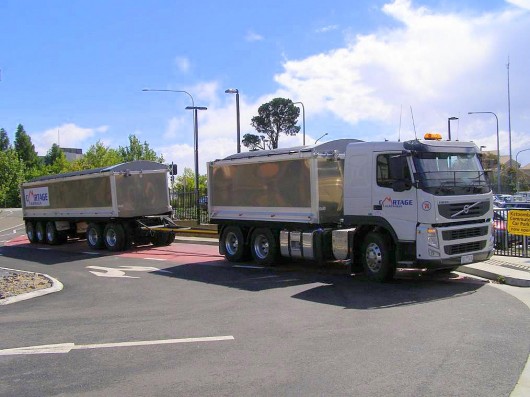 Cartage Australia’s demonstration B-double sand tipper Volvo truck
22 metres long – parked in Katoomba, Blue Mountains.
(Photo by Editor, 20120210, free in public domain, click photo to enlarge) Cartage Australia’s demonstration B-double sand tipper Volvo truck
22 metres long – parked in Katoomba, Blue Mountains.
(Photo by Editor, 20120210, free in public domain, click photo to enlarge)
.
Like most news across the Blue Mountains region concerning issues likely to pose a significant impact upon the community and the environment, one learns about it on the grapevine.
So two weeks ago, I learnt about this Melbourne trucking company planning to introduce 22 metre long B-Double trucks along the Great Western Highway. Such long trucks are currently banned as being too long for this regional highway through the many towns, villages and residential and school zones of the Blue Mountains.
I learn that the trucking company, Cartage Australia, is due to demonstrate one of its B-Doubles to the local community and in the process try to justify why it should be exempt from the current New South Wales Government prohibition. But the announcement is not a general public one, so naturally only a handful of the community turn up to the demonstration, because only a handful of the community were made aware.
.
Why Are Oversized and Overmass Trucks Restricted?
.
Heavy vehicles using the Great Western Highway between Victoria Pass and Lapstone Hill are currently restricted to being no more than 19 metres in length. Such vehicles are deemed to be ‘oversized’ and or ‘overmass’ to mix normally with day-to-day traffic.
According to the RTA’s (recently renamed ‘RMS’)…
“As stated in the General Class 1 Oversize (Load-Carrying Vehicle) Notice 2007 and the General Class 1 Oversize (Special-Purpose Vehicle) Notice 2007, night travel on the Great Western Highway between the Nepean River at Emu Plains and Medlow Bath for vehicles wider than 2.5 metres or longer than 19 metres is only permitted between 1.00am and 5.00am.”
[Source: ‘RTA Operating Conditions Oversize Overmass’ Version 2, 2008, page 23, New South Wales Roads and Traffic Authority, ^http://www.rta.nsw.gov.au/heavyvehicles/downloads/operating_conditions-oversize_overmass.pdf , >Read document (pdf) 720kb]
.
The following justifications identified by the South Australian Director of Road Safety Legislation are just as pertinent to New South Wales:
.
- The need for suitable protection of the State’s road system from structural damage
- The safety and convenience of all road users
- The capability of the vehicle to safely carry the load
- Environmental impacts
- Equitable treatment of all sectors of the industry.
.
[Source: ‘Policy for the Transport of Oversize and Overmass Indivisible Loads and Vehicles, MR 434 06/06, June 2006, South Australian Government, Department for Transport Energy and Infrastructure, ^http://www.transport.sa.gov.au/pdfs/freight/policy_indivisible_vehicles.pdf, Read Document (pdf) 930kb]
.
In New South Wales, rules governing B-Doubles are prescribed under the RTA B-Doubles General_notice_2005 (The Road Transport (General) Act 2005 – General B-Double Notice under Division 4 of Part 2 of the Road Transport (Mass, Loading and Access) Regulation, 2005. >Read Regulation (pdf) (690kb)
.
The Sand Cartage Contract
.
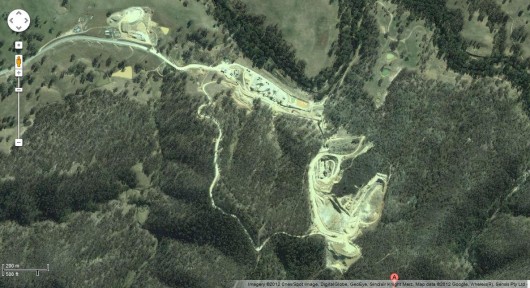 Hy-Tec’s Sand Quarry south of Hartley
(Google Maps)
Hy-Tec’s Sand Quarry south of Hartley
(Google Maps)
.
Melbourne-based construction material trucker, Cartage Australia, is bidding for a sand cartage contract to Hy-Tec to deliver construction sand to the Sydney markets using 22 metre B-double trucks. This will mean many of these long B-double sand trucks dominating the Great Western Highway over the Blue Mountains. The route is to be from Hy-Tec’s sand quarry from Jenolan Caves Rd south of the village of Hartley to Sydney.
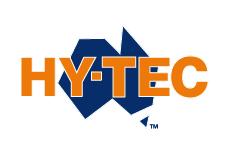
Hy-Tec is a group of companies which are wholly owned by publicly listed Adelaide Brighton Limited, a prominent Australian construction materials and lime producing company with operations throughout Australia. Two major construction projects that Hy-Tec is currently delivering to in Sydney include ‘The Ark’ – a 21 storey commercial high-rise in North Sydney and Presida’s T1 industrial 35,000 cubic metre industrial building complex at the Norwest Business Park in Bella Vista.
Director of Cartage Australia, Wayne Vella, argues that his Volvo fleet of B-doubles are “longer but safer”. Yet according to its website,
“HY-TEC’s focuses on accurate delivery times, taking direct customer enquiries at each concrete plant and quarry, supported by a large fleet of concrete trucks for quick response and best in class on time delivery.”
.
This time-critical delivery focus necessitates that the sand cartage from Hartley to Sydney will be time critical. This means the pressure will be on drivers to meat delivery deadlines and so they be in a hurry and so this poses risks of more trucks and larger heavier trucks speeding along the Great Western Highway, undermining the safety of the road for other road users.
Cartage Australia provides its services 24 hours a day, seven days a week, hauling quarry products around Melbourne – and more recently, throughout Sydney, following the opening of a new facility late last year. This means the sand cartage over the Great Western Highway has potential to be 24 hours a day.
“We opened the Sydney operation so that we can offer the same sort of service to customers there as we provide in Melbourne, and so that we can continue to grow the company. Customers can call the company at any time and we’ll strive to get the job done for them,” says Ray.
Although the Sydney arm of the business has only been fully operational for a few months, Ray is already looking at ways to further grow the business. “Wayne and I want to grow Cartage Australia as much as we can,” says Ray, as he points to further growth planned for 2012.
[Source: ‘Cartage Australia – driven by determination’, Prime Moving Magazine, February 2012, ^http://www.primemovermag.com.au/featured/article/cartage-australia-driven-by-determination]
.
The Big Sell
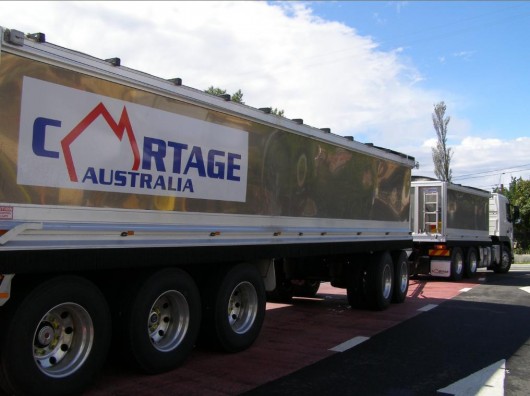
At the outdoors meeting on Friday 10th February 2012 staged by Cartage Australia to a handful of the local community at Katoomba, the demostration truck was all but straight out of the factory. It was bright, shiny, new tyres, flawless and made for selling the company’s point of view. The sell was all about providing Performance Based Standards (PBS) for trucking to get around the 19 metre truck length restriction. That needs to be explained by government.
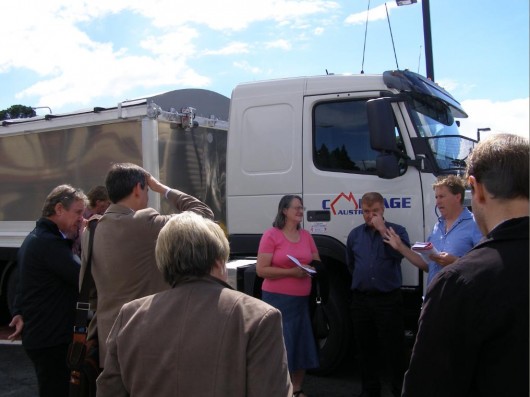 Director Wayne Vella explaining all the positives about his shiny FM480 Volvo Director Wayne Vella explaining all the positives about his shiny FM480 Volvo
.
But when Vella started his long spiel about the truck’s state of the art features and benefits, the focus became all about the magnificence of his showroom truck and not about the community’s concerns about copping more and longer trucks through the Blue Mountains.
Vella argued that it was not a B-double, but look at the photo of it:
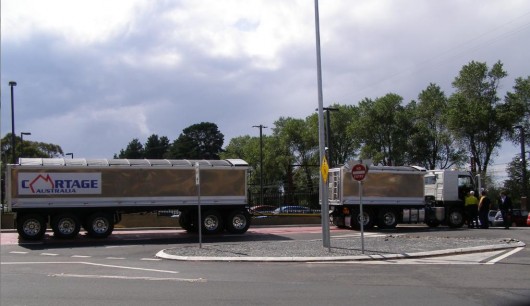 . .
We had to laugh when Vella professed that:
“the exhaust is so clean you could breath it.”
.
“We have applied for a special exemption and this requires us to satisfy all the high performance safety standards in place and also to show the State Government evidence of community support for these trucks. “If we get the nod, we could replace the dog-tipper trucks [used at Hartley Quarry to transport coal to Sydney via the Blue Mountains] with Volvo 500 rigid class trucks within four weeks.”
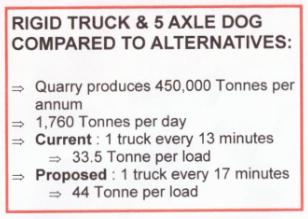 This is Cartage Australia’s current proposal to service the Hartley Quarry
1 truck every 17 minutes This is Cartage Australia’s current proposal to service the Hartley Quarry
1 truck every 17 minutes
.
 This is a Volvo FM480 too and it carts fuel and meets the Euro standards.
A B-double is a B-double. This is a Volvo FM480 too and it carts fuel and meets the Euro standards.
A B-double is a B-double.
.
Here was the politically correct article on the subject published in the local newspaper a few days later. It reads almost as a scripted media release by the trucking company on prime reading page 5.
.
‘Company seeks truck length exemption’
[Source: ‘Company seeks truck length exemption’, by Shane Desiatnik, 20120215, Blue Mountains Gazette, p.5 ^http://www.bluemountainsgazette.com.au/news/local/news/general/company-seeks-truck-length-exemption/2456181.aspx]
.
A Victorian company hopes to gain the support of highway safety lobby groups for a proposal to operate a fleet of “longer but safer” heavy vehicles through the Blue Mountains.
Heavy vehicles using the Great Western Highway between Victoria Pass and Lapstone Hill are currently restricted to being no more than 19 metres in length.
But Cartage Australia has applied to the State Government for a 12-month special exemption to replace its old dog-tipper trucks servicing Hartley Quarry with new 22-metre Volvo trucks.
The company’s director Wayne Vella gave about 15 people a demonstration of the truck’s features at Goldsmith Place in Katoomba on February 10, which include a quiet and energy efficient ‘Euro 5’ standard engine, rollover protection, quiet disc brakes, GPS satellite navigation, 24-hour driver monitoring and larger load capacity.
He said the Volvo trucks set a new benchmark in road safety, did not use noisy compression brakes and three trucks would be able to carry the same load as four dog-tipper trucks, so the number of truck trips per day would decline significantly.
“Yes, the trucks are just under three metres longer than the current limit for the Blue Mountains, but they are not B-double trucks, they only tow one trailer and are only longer to include an extra set of axles to more evenly spread the load,” he said.
“We have applied for a special exemption and this requires us to satisfy all the high performance safety standards in place and also to show the State Government evidence of community support for these trucks.
“We have introduced these trucks in Victoria and we believe if we don’t take this step here you will end up getting older and older trucks on the road that never get replaced.
“If we get the nod, we could replace the dog-tipper trucks [used at Hartley Quarry to transport coal to Sydney via the Blue Mountains] with Volvo 500 rigid class trucks within four weeks.”
Blackheath Highway Action Group chairperson Michael Paag said he would forward information about the proposal at Cartage Australia’s request to members of all highway action groups and other organisations like the Katoomba Chamber of Commerce and Community.
“Members of the general public who are interested in obtaining information or providing feedback about this proposal can contact me,” he said. (Ed. Contact details withheld for privacy).
Mr Vella said he met with Roads and Maritime Services managers in Katoomba also on February 10 to discuss the proposal and notified Member for Blue Mountains Roza Sage in November when the application for the special permit was lodged.’
.
Ed: The message is beware of selective community announcements, as they are selective and not public for reasons to suit the purpose of the protagonist – in this case Cartage Australia’s potentially lucrative contract to truck thousands of tonnes of sand over the Great Western Highway – 1 truck every 17 minutes!
.
NRMA on Truck Safety:
.
Statistics show that road freight continues to grow 1.5 times as fast as the economy, with estimates that freight is expected to double by 2020. The heavy vehicle industry constantly pushes for increases in length and load.
According to the NRMA, it is important for truck drivers to keep a safe following distance. The NRMA believes any changes should be balanced with improved safety and environmental performance. As such NRMA would like to see heavy vehicles equipped with front, side and rear under-run guards (to ensure light vehicles don’t run underneath the heavy vehicle in the event of a crash) and ABS brakes. ABS brakes allow the driver to steer while braking heavily and minimise stopping distances.
NRMA also believes heavy vehicles should be equipped with tamper-proof, on-board monitoring and speed limiting equipment. Electronic on-board monitors can better observe driving hours and driver behaviour.
NRMA also sees a need for increased enforcement of heavy vehicle speed limits. The RTA has introduced its ‘Three Strikes’ scheme, aimed at penalising heavy vehicles which are repeatedly caught exceeding the speed limit (if three strikes are recorded in a three year period the vehicle’s regisitration is suspended). However, they do have to be caught first. A trailer has a different licence plate number to the prime mover which can make it difficult to identify the vehicle when it is photographed from the rear.
NRMA would like to see all heavy vehicle camera enforcement use front and rear detection.
NRMA also supports opportunities to put more freight onto rail where distances are long and freight is suited to rail transport, but it’s naive to think that rail can transport everything.’
.
[Source: ‘Sharing roads with trucks’, by Karen Fittall, ‘Open Road’ members magazine, NRMA, September/October 2005, ^http://www.mynrma.com.au/cps/rde/xchg/mynrma/hs.xsl/heavy_going.htm]
.
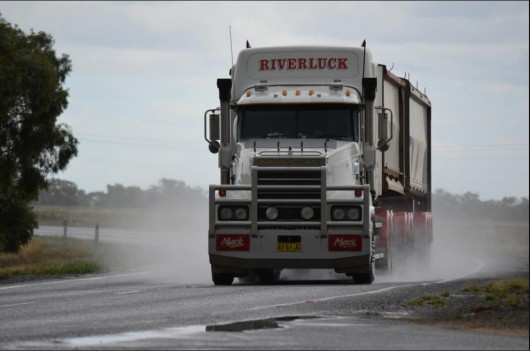 Speeding trucks too dangerous for the Blue Mountains
[Source: ‘Riverluck Mack’ Flickr, ^http://www.flickr.com/photos/quarterdeck/ Speeding trucks too dangerous for the Blue Mountains
[Source: ‘Riverluck Mack’ Flickr, ^http://www.flickr.com/photos/quarterdeck/
.
But the problem is not so much the performance of one trucking company that is aspiring to deliver best practice performance safety, as Cartage Australia is publicly promising.
The problem is the precedent created that permitting one company with 22m long B-doubles will be the thin policy wedge that will allow less conscientious truckers to ply regional roads through residential and school zones. The problem is one of road safety and across the Blue Mountains, road safety especially when it comes to trucks, has a dismal and worsening road toll record. As the Great Westren Highway is transformed into a dedicated high speed trucking expressway, it becomes more dangerous.
Cartage Australia may indeed be offering the safest truck on any Australian road, but who is monitoring and enforcing best practice driver behaviour 24 hours a day? No one!
Road behaviour is simply not monitored and enforced properly by government. As more and bigger trucks speed along our highways, our highways are becoming dangerous life and death environments which is unacceptable.
.
The Habitat Advocate recommends the following standards for the Great Western Highway through the Blue Mountains:
.
- No B-doubles, only semi-trailers, rigid trucks and smaller to be permitted to use the Great Western Highway between Hartley and Penrith. B-doubles to use the Bells Line of Road route.
- NSW Government to suspend all new expressway development, and instead to focus on a Safety First Policy, implementing safety improvements to the current Great Western Highway width between Lawson and Lithgow, noting that the widened sections east of Lawson all but completed or work in progress
- Government and freight industry to mandatorily have feasibility study into rail alternatives for any proposal for increasing road line haul – study to be independent and published online with a month of completion
- Minimum of four speed cameras and four red light cameras installed on the Great Western Highway between Hartley and Nepean River, all hidden and each rotated during the year. This is to be a permanent arrangement.
- Minimum of three speed cameras installed on the Bells Line of Road between Lithgow and Windsor, all hidden and each rotated during the year. This is to be a permanent arrangement.
- Quality controls introduced for heavy vehicle drivers with ongoing spot checks by both Police and RTA (RMS) – including, highway monitoring of driver behaviour – tail gating, exhaust brake usage, speeds, log book compliance, vehicle condition, load safety, mobile phone usage, higher professionalism standards, etc.
- Time-based pay to replace all trip based remuneration of all heavy vehicle drivers across NSW
- Heavy vehicle drivers required to respect and accept variable speed zones across the Great Western Highway, especially through towns and villages and the 40kph zone limits during school morning and afternoon – double demerits for heavy vehicle drivers to reflect the seriousness of heavy vehicles breaching these laws
- A mandatory concrete barrier to be installed on the entire length of the Great Western Highway between Lithgow and Penrith that an withstand collision by heavy vehicles to prevent head-on collisions
- A maximum 75kph speed limit for all heavy vehicles to be imposed on the Great Western Highway between Penrith and Lithgow
- The NSW Government to prepare an economic business case to show the Return on Investment and Pay Back of the Mt Victoria Bypass estimated to cost $1 billion
- Prohibit heavy vehicle parking along the highway in Mount Victoria, particularly in the vicinity of the Caltex Service Station. This to be signposted accordingly, monitored by the RTA (RMS) and fines to apply for transgressions
- RTA (RMS) to construct one fully accredited heavy vehicle rest area at Mount Boyce on both sides of the highway, and a second at Falconbridge on both sides of the highway to fully comply with the standards set by the National Transport Commission’s Heavy Vehicle Driver Fatigue Legislation, which came into effect on 29 September 2008.
.
Postcript:
.
Blue Mountains Gazette 20071001:
Victoria Pass
Monday, 1 October 2007
Posted By Dean Driscoll, Mt Victoria.
‘Another horrific accident going down the hill at Mt Vic on Sunday. The whole zone from just east of the township to the bottom of the mountain is 60km/hour yet a large percentage of drivers going through Mt Vic seem to struggle to brake to that limit. Surely the area must be regarded as a black spot?
With persistant tail-gaters trying to speed their way through as if it was a freeway, it is time the authories give a serious look at how to manage an out of control situation’.
.
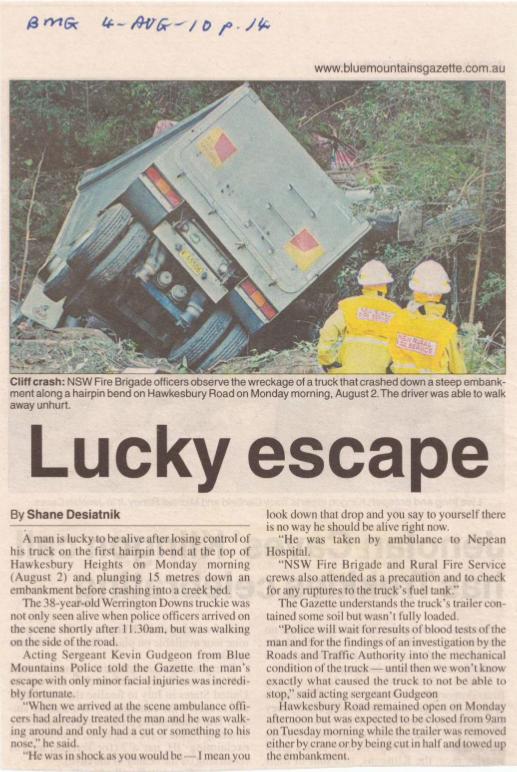
.
 . .
Tuesday, February 21st, 2012
This article was initially published on 20110728 by the UK based Environmental Investigation Agency (EIA) under its press release entitled ‘Vietnamese Army named as timber smuggler’, Contact: EIA, 62-63 Upper Street, London N1 0NY, United Kingdom, ^www.eia-international.org]
.
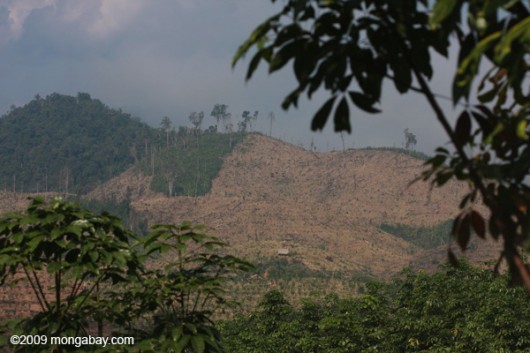 Forests in Laos have declined steadily in recent decades,
falling from 64% cover in 1960 to 41% in 2005.
Primary forests now cover less than 10 % of the country according to U.N. data.
(Source: Mongabay, ^http://news.mongabay.com/2011/0622-laos_crackdown.html) Forests in Laos have declined steadily in recent decades,
falling from 64% cover in 1960 to 41% in 2005.
Primary forests now cover less than 10 % of the country according to U.N. data.
(Source: Mongabay, ^http://news.mongabay.com/2011/0622-laos_crackdown.html)
.
BANGKOK: A new report released today (20110728) exposes the pivotal role played by the Vietnamese military in a multi-million dollar operation which is smuggling threatened timber over the border from the shrinking forests of neighbouring Laos.
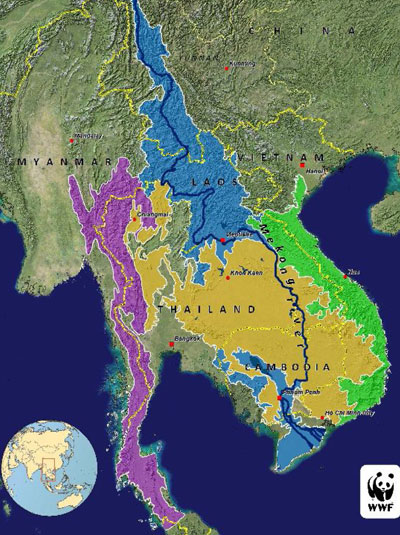 Greater Mekong Region Greater Mekong Region
.
Laos has some of the Mekong region’s last intact tropical forests, but the London-based Environmental Investigation Agency (EIA) report Crossroads: The Illicit Timber Trade Between Laos and Vietnam reveals its export ban on raw timber is routinely flouted on a massive scale to feed the ravenous timber processing industries of Vietnam, China and Thailand.
During undercover operations in 2010 and 2011, EIA agents posing as timber buyers tracked a trail of corruption and inadequate enforcement back from the busy furniture factories and ports of Vietnam to its border with Laos and beyond.
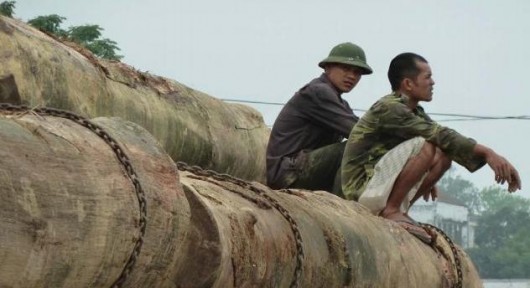 The forests of Laos support the livelihoods of millions of rural and indigenous people but are seriously threatened by over-exploitation; such is the volume of illegal timber flowing through Laos’ porous borders that its furniture manufacturing industry is finding it cannot supply orders due to a lack of raw materials. The forests of Laos support the livelihoods of millions of rural and indigenous people but are seriously threatened by over-exploitation; such is the volume of illegal timber flowing through Laos’ porous borders that its furniture manufacturing industry is finding it cannot supply orders due to a lack of raw materials.
Through investment in logging, plantations and hydropower projects, Vietnamese firms have appropriated large swathes of Lao forests, yet the only winners in Laos are corrupt Government officials and well-connected businessmen. Meanwhile, Vietnamese logging companies and furniture factories are booming on the back of the illegal trade, exporting billions of dollars worth of finished wood products to the major markets of the USA and European Union.
And EIA’s investigations revealed that one of the biggest loggers in Laos is a company owned by the Vietnamese military. Investigators first encountered the Vietnamese Company of Economic Cooperation (COECCO) in October 2010 during a visit to Qui Nhon port, documenting huge piles of logs bearing green paint marks and tagged with yellow labels bearing a Vietnamese name which translated into Company of Economic Cooperation – Ministry of Defence (or COECCO). A port worker said 95 per cent of the logs had come from
Laos and most were owned by the Vietnamese military; specifically Military Zone 4.
Similarly marked logs were observed in a huge storage area between the two formal checkpoints at the Bo Y border crossing (‘F‘ on map below) and EIA was eventually able to confirm that most of them had come from logging operations linked to the construction of a nearby hydropower dam.
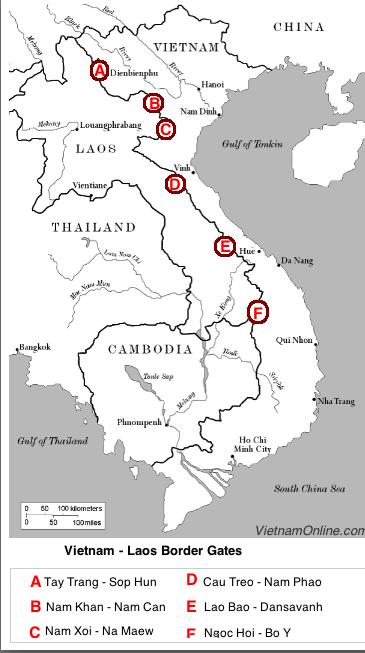
To uncover more details of the company’s operations, EIA investigators travelled to COECCO’s headquarters in Vinh City, Vietnam, in May 2011 and learnt COECCO has been in the timber trade and logging business in Laos for more than 20 years, that it sources most of its logs from Lao dam clearance sites and that it is one of a handful of companies permitted to carry out logging in these areas.
A well-connected Lao company is also making a fortune trading logs to Vietnam; the Phonesack Group, the boss of which is connected with the Lao Government, prefers to send logs across the border while its own wood processing struggles to get supplies of raw material.
EIA Head of Forest Campaign Faith Doherty said:
“EIA first exposed the illicit log trade between Laos and Vietnam in 2008, and our latest investigations reveal that sadly nothing has changed.
“The governments of Vietnam and Laos urgently need to work together to stem the flow of logs and curb the over-exploitation of Laos’ precious forests before it’s too late, and the Vietnamese military must be excluded from logging operations in Laos. “With a new Timber Regulation coming into force within European markets in 2013, both Vietnam and Laos have a lot at stake and urgently need to work with the European Union.”
.
Urgent Call to Action – by EIA
.
1. THE GOVERNMENT OF LAOS SHOULD:
- Enforce its log export ban
- Publish details of all logging quotas and the selection process
- Clarify rules for converting forest land for plantations
.
2. THE GOVERNMENT OF VIETNAM SHOULD:
- Respect the policies of the Lao Government by blocking log imports from the country
- Hold bilateral talks with the Government of Laos over illicit wood trade between the two countries
- Work with Vietnamese wood industry associations to exclude Lao logs from its supply chain
- Exclude military businesses from carrying out logging operations in Laos
.
3. THE EUROPEAN UNION SHOULD:
- Ensure that any Voluntary Partnership Agreement (VPA) discussions with Vietnam and Laos address the issue of log trade between the two countries
- Ensure that VPA talks include the full range of stakeholders
- Promote forest governance lessons from FLEGT (Forest Law Enforcement, Governance and Trade) into the development of REDD+ (Reducing Emissions from Deforestation and Forest Degradation) , specifically in terms of displaced deforestation
.
4. COMPANIES AND CONSUMERS SHOULD:
- Obtain proof that wood products sourced from Vietnam are not derived from logs imported from Laos
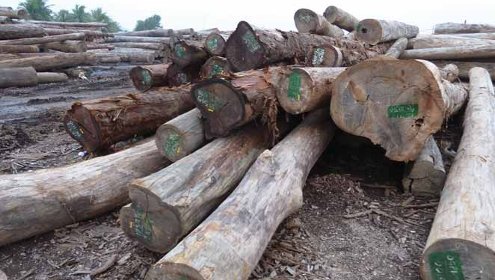
Copies of the full Crossroads report, stills and footage are available on request from Environmental Investigation Agency (EIA) Press Officer Paul Newman at paulnewman@eia-international.org, or or Faith Doherty at faithdoherty@eia-international.org.
.
Illegal logging and the associated trade in stolen timber
.
[Source: ‘Transnational Organised Crime in South East Asia: Threat Assessment‘, article in newsletter ‘NTS Alert’, July 2010 (Issue 1), published by the Centre for Non-traditional Security Studies (NTS), within the S. Rajaratnam School of International Studies (RSIS), Graduate School of Nanyang Technological University, Singapore, ^http://www.rsis.edu.sg/nts/HTML-Newsletter/alert/NTS-alert-jul-1001.html]
.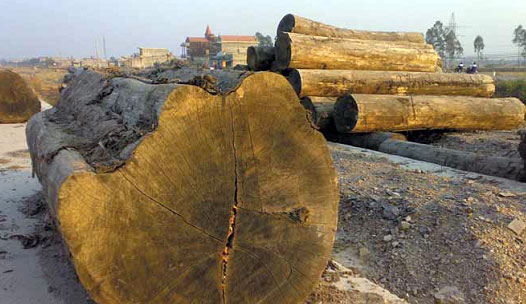 Yellow balau log from Lao Peoples Democratic Republic, awaiting transportation. Yellow balau log from Lao Peoples Democratic Republic, awaiting transportation.
(Photo : Environmental Investigation Agency, 2008)
.
Illegal logging occurs when timber is harvested, transported, processed, bought, or sold in violation or circumvention of national or sub-national laws (Miller et al., 2006). Between 8 and 10 per cent of global wood products stems from illegal logging, with annual global market value of losses estimated at over USD 10 billion (United Nations Office on Drugs and Crime – UNODC, June 2010). Southeast Asia is a major supplier of illicit timber with an estimated annual turnover of USD 3.5 billion. As much as 40 per cent of wood-based products imported into the EU in 2008 and half of China’s imports in 2007 (worth USD 900 million) originated from illegal logging.
Indonesia remains the country most heavily affected by illegal logging. The country possesses 123 million ha of forest (10 per cent of global forest cover) including the third largest tropical rainforest. As much as 80 per cent of timber logged in Indonesia is suspected to be illegally sourced with annual losses in government revenue estimated at USD 2 billion (Human Rights Watch, 2009). The Indonesian Ministry of Forestry estimates that in recent years, the country lost between 1.6 and 2.8 million ha of forest annually (between 3 and 5 ha a minute) to illegal logging and land conversion (UNODC, June 2010).
.
Imported Rainforest Timbers to Australia
[Source: ‘The Good Wood Guide: A Residents Guide to Purchasing Environmentally Friendly Timber’, Waverley Council, NSW, ^http://www.wettropics.gov.au/st/rainforest_explorer/Resources/Documents/8to9/GoodWoodGuide.pdf]
.
About 13% of Australia’s sawn timber is sourced from tropical forests. We also import tropical rainforest timber items such as veneers, plywoods and picture mouldings. The majority of these timber products are sourced from unsustainably logged forests and could be replaced by sustainable locally grown alternatives.
Logging tropical rainforests causes the extinction of hundreds of plant and animal species each year in addition to loss of the home of many indigenous tribal peoples. In South East Asian rainforests the rate of clearing is five million hectares per year. Once an intact rainforest has been destroyed, it cannot be replaced for thousands of years.
Ed: A rainforest is not a ‘renewable resource’. Rainforest timber is driving extinctions.
.
Commonly Imported South East Asian Rainforest Timbers to Avoid
.
- Meranti
- Merbau
- Ramin
- Pacific Maple
- Philippine Mahogany (Calantas)
- Keruing (also known as Naytoh, Narra and Kapur)
- Teak
- Jelutong
- Motoa (also known as Merawan, Batu)
- Balau
.
Old-Growth Forests
.
‘Old-growth forests are native forests which have had no recent disturbance by humans and regenerate naturally over hundreds of years. Like rainforest, old growth forests provide vital habitats for many species of flora and fauna. These forests are becoming increasingly rare both overseas and in Australia. Consequently we recommend that you avoid timbers sourced from old growth forests.’
Chea Sa Timber wholesales SE Asian rainforest timbers

…’We are a well established trading company situated in Malaysia. We have been in this industry since year 1995 and have earned superb reputation in our business circle. We offer a large variety of Tropical sawn timber. We have excellent sources and reliable network to fulfill both local and international market. ‘Currently, our overseas customers including Singapore, Hong Kong, China, Japan & etc. We intend to further expand our business to new markets abroad and looking for long term business partners worldwide.
Products
We specialize in following sawn timber, size in accordance to customer’s requirement:
- Finger Jointed Wood (Meranti, Durian, Sesendok)
- Meranti (Light Red/Dark Red)
- Kapur
- Kempas
- Keruing
- Merbau
- Merbatu
- KSK (Kembang Semangkok, or ‘Samrong’)
- Yellow Balau (Selangan Batu) & etc
.
[Source: ^http://www.cheasatimber.com/index.html]
.
‘Serano Timber’ in Dandenong Victoria retails Yellow Belau’
.
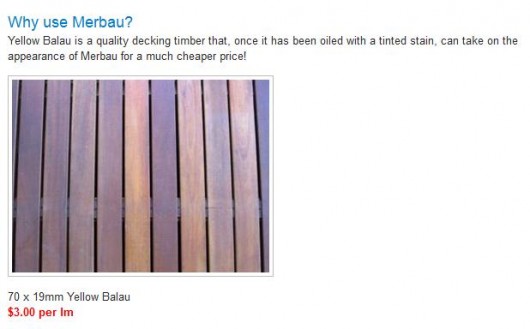
 Source: ^http://www.seranotimber.com.au/yellow-balau.html
Source: ^http://www.seranotimber.com.au/yellow-balau.html
.
Further Reading:
.
[1] FLEGT (Forest Law Enforcement, Governance and Trade), ^ http://www.euflegt.efi.int/portal/ ‘The Forest Law Enforcement, Governance and Trade (FLEGT) Action Plan sets out a range of measures available to the European Union and its Member States to tackle illegal logging in the world’s forests. Use the menu on the left to find more information about the FLEGT programme.’
.
[2] UN-REDD (Reducing Emissions from Deforestation and Forest Degradation), ^ http://www.un-redd.org/ ‘ The UN-REDD Programme is the United Nations Collaborative initiative on Reducing Emissions from Deforestation and forest Degradation (REDD) in developing countries. The Programme was launched in September 2008 to assist developing countries prepare and implement national REDD+ strategies, and builds on the convening power and expertise of the Food and Agriculture Organization of the United Nations (FAO), the United Nations Development Programme (UNDP) and the United Nations Environment Programme (UNEP).’
.
[3] Illegal Logging (UK-based) website, ^ http://www.illegal-logging.info/index.php , ‘ The purpose of this site is to provide information on the key issues in the debate around illegal logging and the trade in illegal timber, via news stories and key documents, as well as details of relevant events, and links to other relevant websites.’
.
Tags: Balau, Bo Y border crossing, Greater Mekong Region, illegal logging, Illicit Timber Trade, Lao Government, Laos, Phonesack Group, rainforest timber, Vietnamese Army, Vietnamese Company of Economic Cooperation, Voluntary Partnership Agreement
Posted in Mekong (VN), Threats from Deforestation | No Comments »
Add this post to Del.icio.us - Digg
Monday, February 20th, 2012
 “Let us bind ourselves tightly to the Sorrowful Heart of our Heavenly Mother and reflect on it’s boundless grief and how precious is our soul.” “Let us bind ourselves tightly to the Sorrowful Heart of our Heavenly Mother and reflect on it’s boundless grief and how precious is our soul.”
~ Saint Padre Pio
.
Kangaroo meat involves live castration. Would you like red wine, pear juice and cranberry jelly with that?
The following video confirms Australia’s rural culture encouraging a psycho-sadistical and brutal hate towards wildlife.
It could be of elephants or rhinos in Africa, it could be Nazi Germany or Poland, or Rwanda or Serbia, but it is rural Australia and its precious wildlife. It is 19th Century depraved sadism and kangaroo slaughter is condoned by Julia Gillard’s Australian Government. This is how rural Australian shooters treat wildlife, like Japanese fishermen treat dolphins at Taiji.
It is akin to the teenage deviantism of Tasmanian mass murderer Martin Bryant and straight out of the film Wolf Creek .
.
WARNING: This video is extremely disturbing and not suitable for children. But it needs to be made public! In 2012 it reflects the callous reality of rural Australia. No wonder urban Australia turns its back on rural Australians and starves them of funding – such sadists only deserve an eye for an eye.
Click to view video:
.
Honesty, I could not inflict such callousness on any sentient being.
But if I was sure of the culpability of such a monster, wildlife thereafter would have no fear.
.
Tigerquoll
Suggan Buggan
Snowy River Region
Victoria 3885
Australia
Tags: holy mary, kangaroo meat, kangaroo slaughter, kangaroo slaughter for fur, kangaroos, Martin Bryant, rural Australia, Taiji, tigerquoll, wildlife slaughter, Wolf Creek
Posted in Kangaroos and Macropods, Threats from Poaching and Poisoning | No Comments »
Add this post to Del.icio.us - Digg
Sunday, February 19th, 2012
This article was initially posted by Tigerquoll 20120202 as a comment on the Tasmanian Times newspaper to an article entitled ‘Gunns’ Pulp Mill lifeline extended – community will protest‘ by Anne Layton-Bennett, Friends of The Tamar Valley (20120201).
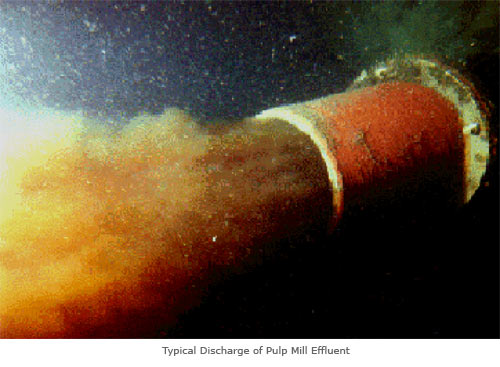 . .
The ANZ Bank publicly claims it has adopted the Equator Principles of the World Bank’s International Finance Corporation (IFC).
These are ‘voluntary standards designed by the World Bank’s International Finance Corporation (IFC) to help banks identify and manage social and environmental risks associated with the direct financing of large projects‘ – i.e. Natural Resource projects like Gunns Pulp Mill.
[Source: ANZ Bank website, ^ http://www.anz.com/aus/values/environment/Equator.asp]
.
“ANZ has voluntarily committed to fund only new projects that can be developed and operated according to sound social and environmental standards.”
~ ANZ website
 ANZ Bank’s new brand represents a bank “for the people”
For the people or for its executives? ANZ Bank’s new brand represents a bank “for the people”
For the people or for its executives?
.
As at 1 Jan 2012, the IFC’s Equator Principles Performance Standard 3 ‘Resource Efficiency and Pollution Prevention” states that its aim is
- To avoid or minimize adverse impacts on human health and the environment by avoiding or minimizing pollution from project activities.
- To promote more sustainable use of resources, including energy and water.
- To reduce project-related GHG emissions.
.
ANZ’s prominent project finance client, Gunns and its planned Tamar Valley Pulp Mill project seems set to fail each of these objectives in its airborne emissions and waste water. In September 2007, the ANZ was ranked the most sustainable bank globally by the Dow Jones Sustainability Index. So what is the ANZ Bank not telling the IFC?
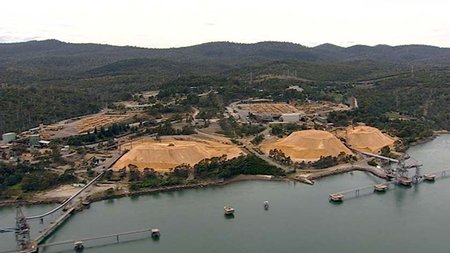 A Gunns Woodchip Mill at Longreach, Tasmania A Gunns Woodchip Mill at Longreach, Tasmania
.
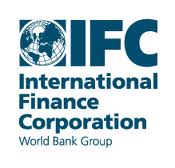 . .
IFC’s Sustainability Framework – 2012 Edition:
Performance Standard 6: ‘Biodiversity Conservation and Sustainable Management of Living Natural Resources’
Clause 14: The client will not significantly convert or degrade natural habitats, unless all of the following are demonstrated:
- No other viable alternatives within the region exist for development of the project on modified habitat;
- Consultation has established the views of stakeholders, including Affected Communities, with respect to the extent of conversion and degradation;8 and
- Any conversion or degradation is mitigated according to the mitigation hierarchy.
.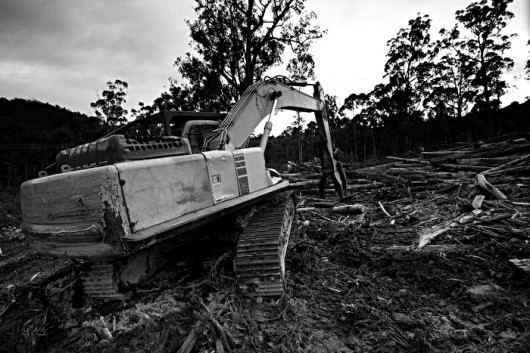 Gunns Clearfell of Tasmanian Heritage
© Photo by Alex Wise
Source: ^http://www.alexwisephotography.net/blog/2008/11/08/tasmania-clearfelling/ Gunns Clearfell of Tasmanian Heritage
© Photo by Alex Wise
Source: ^http://www.alexwisephotography.net/blog/2008/11/08/tasmania-clearfelling/
.
Clause 17: In areas of critical habitat, the client will not implement any project activities unless all of the following are demonstrated:
- No other viable alternatives within the region exist for development of the project on modified or natural habitats that are not critical
- The project does not lead to measurable adverse impacts on those biodiversity values for which the critical habitat was designated, and on the ecological processes supporting those biodiversity values
- The project does not lead to a net reduction in the global and/or national/regional population13 of any Critically Endangered or Endangered species over a reasonable period of time;
- A robust, appropriately designed, and long-term biodiversity monitoring and evaluation program is integrated into the client’s management program.
.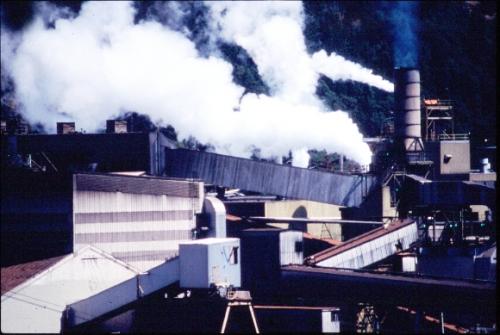
Back to ANZ’s website…
‘ANZ will comply with the Principles for all project finance proposals, regardless of their size, and apply the same Equator Principles standards to all projects in all countries.’
.
These people don’t think so..
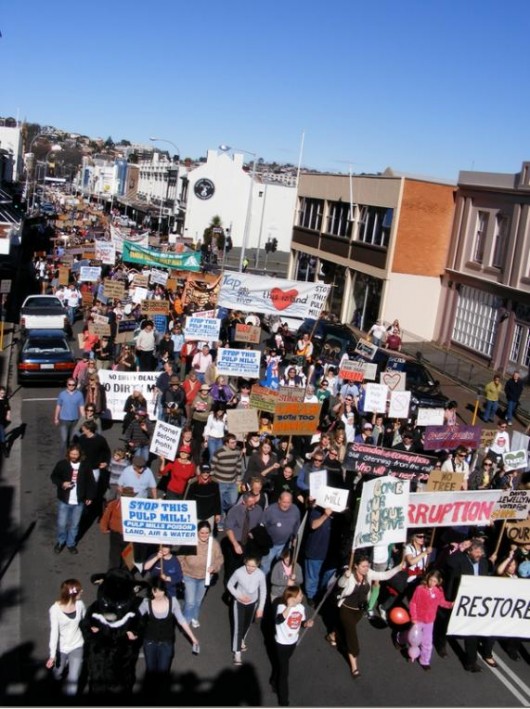 Pulp Mill protest, Launceston Tasmania
A pulp mill for the people? Pulp Mill protest, Launceston Tasmania
A pulp mill for the people?
.
Grassroots community action group in Tasmania, Pulp the Mill Alliance, continues to oppose Gunns’ proposed Tamar Valley Pulp Mill for the following reasons:
- Toxic effluent in Bass Strait
- Threats to the livelihood and lifestyle of thousands of Tamar Valley residents
- Fresh water usage
- Possible future use of native forests
- The draconian and undemocratic Section 11 of the Pulp Mill Assessment Act
- Lack of an independent, transparent assessment of a “critically non-compliant” mill
- Lack of public hearings and community consultation
- A complete lack of integrity on Gunns’ part
.
The No Pulp Mill Alliance is undertaking a national campaign to warn the ANZ that if they renew their debt facility to Gunns Ltd then we will renew our national campaign targeting ANZ as the bank that is financing the corruptly approved, environmentally destructive, divisive, and financially risky Tamar Valley pulp mill.
‘We will be placing national advertisements, undertaking direct actions, sending letters/petitions, and anything else it takes to let ANZ know that we don’t want them to finance the Gunns’ Tamar Valley pulp mill.’
With Gunns’ share price at its lowest ever and a capital equity of only $82 million, Gunns Ltd is in serious financial trouble. It is selling everything to try and get its pulp mill built. In fact, the name Gunns Ltd could now be considered as synonymous with the Tamar Valley Pulp Mill.
Gunns has a net debt of $616 million, of which the primary financing facility – a $350 million senior debt facility – is maturing in January 2012. ANZ is the primary financing facility and thus is the Aussie Bank that keeps Gunns standing. Current site works taking place to prepare for construction of the proposed pulp mill are directly financed by the ANZ bank.
Gunns’ Chairman stated in his Annual General Meeting speech in November 2011 that Gunns Ltd is in discussion with ANZ to extend the debt with the: “objective of these discussions is to provide financing terms which facilitate the completion of the asset sale program and financial close of the Bell Bay pulp mill project.”
 Gunns’ pulp mill site on the Tamar River, Tasmania Gunns’ pulp mill site on the Tamar River, Tasmania
.
We demand that ANZ do not extend the debt facility for Gunns Ltd, and warn ANZ that if it does announce an extension of the debt facility, then our national campaign will result in letting its customers know worldwide that it is backing a polluting project that does not comply with the Equator Principles.’
[Source: ANZ Campaign to stop funding the Pulp Mill, ^http://www.pulpthemill.org/]
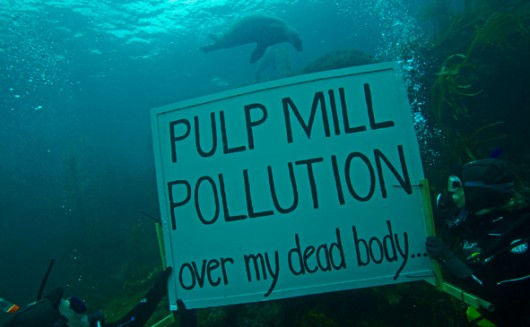 . .
The current ten banks committed to Gunns in a syndicated loan are gambling solely on the go ahead and profitability of the proposed Pulp Mill.
Whereas Gunns once had a reliable cash inflows stream from multiple revenue streams – plantation sales including interstate, sawmilling, and hardware earlier on, all non pulp mill assets are being treated as “non-core”.
This strategy has already shown to be poor by the fire sale desperation of these assets in order to maintain operating cash flow to remain solvent, while the myopic focus on the proposed $2.3 billion Bell Bay pulp mill drives the Gunns’ Board. Gunn’s revenue strategy is hedged on one big risky pulp mill – risky from the point of view of fickle international market demand and pulp commodity prices, mired by political controversy and considerable community opposition to the mill.
It’s equivalent to gambling all the $340 Million on the red to win on the roulette wheel.
These banks must be privy to some revenue guarantees and that is likely from ‘commercial in confidence’ assurances from the Tasmanian Labor Party.
.
Tigerquoll
Suggan Buggan
Victoria
.
Further Reading:
.
[1] World Bank’s International Finance Corporation (IFC) Equator Principles , ^ http://www.equator-principles.com/
.
[2] Pulp the Mill Alliance Inc. ^ http://www.pulpthemill.org/
.
[3] Friends of the Tamar River, ^ http://ftv.org.au/
.
[4] TAP, ^ http://www.tapvision.info/
.
[5] The Wilderness Society (Tasmania), ^ http://www.wilderness.org.au/regions/tasmania
.
[6] Tasmanian Times (forum), ^ http://tasmaniantimes.com.au/, ‘Tasmanian Times is a forum of discussion and dissent – a cheeky, irreverent challenge to the mass media’s obsession with popularity, superficiality and celebrity’. Article: ^ http://tasmaniantimes.com/index.php?/article/gunns-pulp-mill-lifeline-extended-community-will-protest/
.
[7] Tasmania Clearfelling, Alex Wise Photography, ^ http://www.alexwisephotography.net/blog/2008/11/08/tasmania-clearfelling/
.
Tags: ANZ Bank, Equator Principles, for the people, Gunns, Gunns Pulp Mill, IFC, International Finance Corporation, Natural Resource Projects, pulp mill pollution, Toxic effluent, World Bank
Posted in Tasmania (AU), Threats from Deforestation | No Comments »
Add this post to Del.icio.us - Digg
Saturday, February 18th, 2012
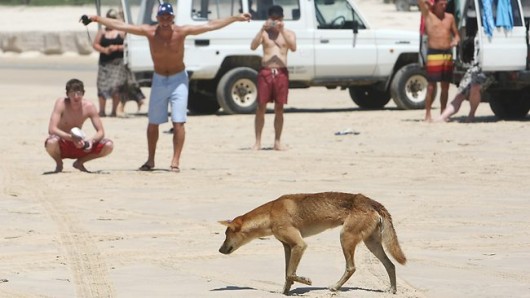 No place for feral tourists on World Heritage Fraser Island No place for feral tourists on World Heritage Fraser Island
.
Remove all ferals from Fraser Island – rabbits, cats, brumbies, gambusia, cane toads, 4WDs, tourists and tour operators!
It’s time to reverse the tables. I’d like to see these exploiters racing towards catastrophic collapse instead of the native dingos – and for any trangressions automatically attract a minimum $200,000 fine and/or 6 months in gaol.
Shut down the Fraser Island Ferry Service and Manta Ray Fraser Island Barge service – pay the ferrymen compensation to retire happily.
Shut down Kingfisher Bay Resort – pay the operator out to retire happily, then convert it into a proper National Parks wildlife research station.
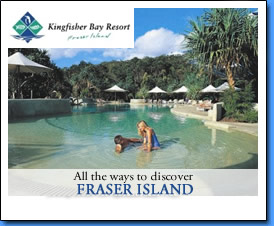 Such 20th Century resort tourism is inappropriate for World Heritage Fraser Island Such 20th Century resort tourism is inappropriate for World Heritage Fraser Island
.
Fraser Island is a National Park. It is world heritage listed by crikes, not as a tourism promotion, but for its ecological values. The place is endangered, the pure native dingo is on its last legs and suffering at the hands of humans, so number one priority of a national park is ecological protection. National Parks Service needs to get its nose out of tourism exploitation and bush arson and back into its job of wildlife ecology management. But it needs to be managed at national level, because the Queensland DERM cowboys can’t be trusted.
There is no reason why the custody of the entire island should not be returned to the traditional Butchulla and Badtjala peoples to oversee the rehabilitatiin and ecological management.
Indeed, Fraser Island should renamed back to the respective indigenous names: K’gari and Gari.
It is time to get serious about ecology. Simple solution, just takes community will and leadership, like in the 1970s grassroots campaign to originally protect the island from Joh’s sand mining pillage.
Get the tourists off Fraser Island. Shut down Base Camp Fraser Island, shut down Eurong Beach Resort, shut down Fraser Island Beach Houses, Fraser Island Fishing Units, Fraser Island Hideaway, Fraser View Apartments, Cathedrals on Fraser camping ground, Fraser Island Waiuta Retreat. Compulsorily acquire their land holdings and put them on the last tourist ferry off the island.
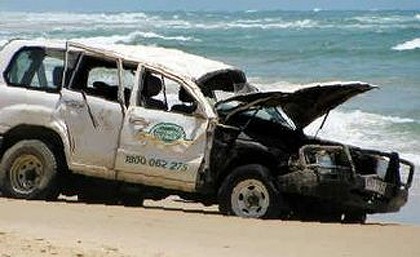 4WD tourist hoons on Fraser Island in 2009
[Source: ‘Overseas tourists drive up Fraser Island 4WD carnage’,
by Tony Moore and Cameron Atfield, Brisbane Times, 20091215,
^http://www.brisbanetimes.com.au/travel/travel-news/overseas-tourists-drive-up-fraser-island-4wd-carnage-20091214-ks6f.html] 4WD tourist hoons on Fraser Island in 2009
[Source: ‘Overseas tourists drive up Fraser Island 4WD carnage’,
by Tony Moore and Cameron Atfield, Brisbane Times, 20091215,
^http://www.brisbanetimes.com.au/travel/travel-news/overseas-tourists-drive-up-fraser-island-4wd-carnage-20091214-ks6f.html]
.
.  Pure Dingo
Threatened, harrassed on its native Fraser Island Pure Dingo
Threatened, harrassed on its native Fraser Island
.
Last April 2011, three Fraser Island dingo pups were destroyed (read ‘executed‘) in as many weeks after displaying aggressive behaviour towards humans, according to the Department of Environment and Resource Management (DERM). DERM general manager Terry Harper said three dingoes from the June/July 2010 litters had “posed a clear threat”’ to the safety of visitors and the community. Fraser Island is the dingos native home. The tourists are feral intruders and the problem, not the dingos. Harper needs to be sacked.
[Source: ‘Three more Fraser Island dingoes destroyed after aggressive behaviour toward campers’, by Kristin Shorten, The Courier-Mail, 20110428, ^http://www.couriermail.com.au/news/queensland/three-more-fraser-island-dingoes-destroyed-after-aggressive-behaviour-toward-campers/story-e6freoof-1226046070071]
.
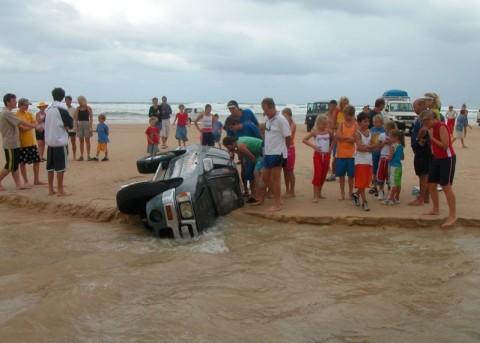 Say no more! Say no more!
.
Bree Jashin of the Fraser Island Dingo Preservation Group says tourists feeding and teasing dingoes on Fraser Island could lead to the extinction of the native dogs on the island. Ms Jashin provided AAP with a photograph of tourists kicking sand at dingoes and a first-hand account of another incident between tourists and a dingo pup, which she said could elicit a reaction and lead to the dingo’s destruction by rangers.
“The right for humans to play at the expense of the future of the only thoroughbred dingoes left is unacceptable,” Ms Jashin said. “Fraser Island is the dingoes’ home and humans have to remember they are guests in that home.
Chris Druery was among a group of three visitors in a four-wheel-drive south of Eli Creek on Fraser Island on October 1 last year when they saw an approaching vehicle drive directly towards a dingo pup.
“[The driver] pointed their vehicle directly towards the pup and sped up, attempting to run it down,” Mr Druery said. “They also swerved violently towards the pup, missing it by only centimetres. “We watched the pup cower and run towards the surf with its hind legs tucked up under its rear end.”
Mr Druery said those in the offending four-wheel-drive were laughing during their attempts to run the dingo down. “It is disappointing that such a jewel in the crown can be tarnished by clowns that drive dangerously on the beach,” he said.
Ms Jashin said the three dingoes in photographs she snapped last year were heading towards Eurong township beachfront when they were harassed by backpackers.
“The pups were simply minding their own business when the girls screamed and the young male backpacker began to aggressively yell, run at, and kick sand at the pups,” she said.
Rather than dissuade the dogs, the yelling attracted them towards the group. “The backpackers all jumped in the vehicle and drove up close to them to take pics,” she said. She said all three of the pups had been destroyed after exhibiting allegedly aggressive behaviour towards humans.
[Source: ‘Tourists ‘threatening dingo extinction’, by AAP, 20100317, ^http://www.smh.com.au/environment/conservation/tourists-threatening-dingo-extinction-20100317-qe1o.html].
.
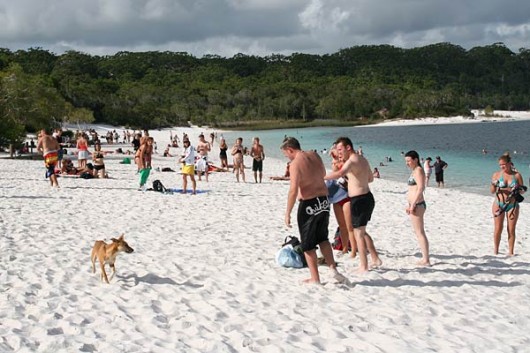 Uncontrolled tourist interation with Fraser Island’s wild dingoes
Tourists and wildlife don’t mix – when will Parks Management get the message ?
DERM is not a tourist operator. Fraser Island is a World Heritage National Park for wildlife. Uncontrolled tourist interation with Fraser Island’s wild dingoes
Tourists and wildlife don’t mix – when will Parks Management get the message ?
DERM is not a tourist operator. Fraser Island is a World Heritage National Park for wildlife.
.
Fraser Island is a wildlife World Heritage sanctuary, not another Hamilton Island Resort!
.
Last September 2011, some bored National Parks officers decided to start a fire on the island. They excused it as a ‘controlled burn’, but is is arson no less and surprise surprise, it got out of control. “It was going for five or six days, and the weather changed and it took off in a different direction, unfortunately. “These things are part of life. In most national parks you need to reduce the fuel load.”
The vandals need to be sacked (including the manager for probably inciting it) banned from Fraser Island and fined for the cost of the emergency response by the 18 fire fighters from Rural Fire Brigade, Queensland Fire and Rescue Service and the 4 waterbombing aircraft.
[Source: ‘A resort on Fraser Island is threatened by a grass fire, which appears to have started with a controlled burn’, by AAP, 20111003, ^http://www.theaustralian.com.au/news/nation/a-resort-on-fraser-island-is-threatened-by-a-major-grass-fire/story-e6frg6nf-1226156969941]
.
Queensland’s Fraser Island was inscribed on the World Heritage List in 1992 after nearly twenty years battle and public debate.
Once it was listed, the Queensland Government has maliciously abused the world heritage for tourism and recreation, allowing the precious island to become so degraded that some people are now arguing that it needs to be placed on the World Heritage in Danger List. (Ed: It should be, right now).
‘It isn’t that Fraser Island lacks the values that warranted its World Heritage listing in the first place. It is just that the management values for Fraser Island are pre-occupied with recreation Management to the neglect of the protection of its World Heritage values.
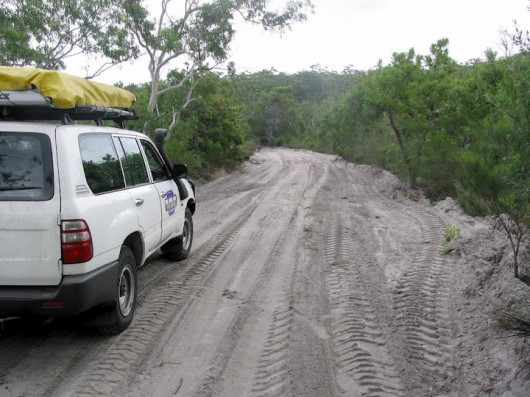 Unmonitored 4WDs
A bit of road widening into Fraser Island’s vegetation Unmonitored 4WDs
A bit of road widening into Fraser Island’s vegetation
.
On Fraser Island ‘bevans‘ rule ok!
‘On Fraser Island 4WD recreational vehicles rule all policy decisions even though environmental studies have conclusively shown the impact of the 4WDs in compacting sand in the substrate and thus accelerating water erosion. The mobilization of sand as a result of this means that over a three year period more than a million tones of sand has been mobilized and sluiced down the slopes. That means over a tonne of sand it relocated for every visitor to Fraser Island!
‘Some roads are now scoured down to a depth of 4 metres and they continue this on-going down-cutting every time it rains. As little as 5mm of rain is more than enough to start mobilizing surface sand on roads. Some of the sand is deposited lower down the slopes; other sand is being sluiced into the iconic perched dune lakes.
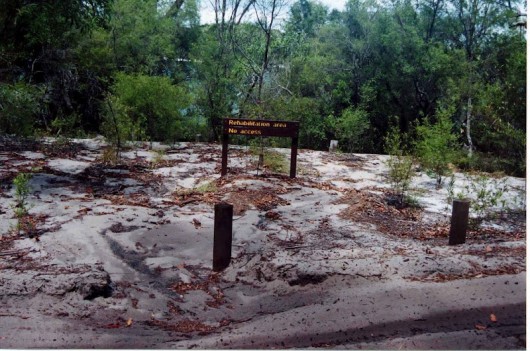 Road to McKenzie – the Parks Service must have gone AWOL Road to McKenzie – the Parks Service must have gone AWOL
.
Some of the sand is deposited so that picnic tables begin to get buried and other picnic spots are being scoured out demonstrating the fragility and mobility of any disturbed soil surface on Fraser Island.
‘In 1963 Indian Head had a lawn of thick grass extending right to its summit. Since then the unprotected surface soil has been disturbed but hundreds of thousands of feet. This has been eroded and washed away by rain exposing an ever expanding area of bare rock. There are no plans to repair the damage or rectify this problem in the foreseeable future.
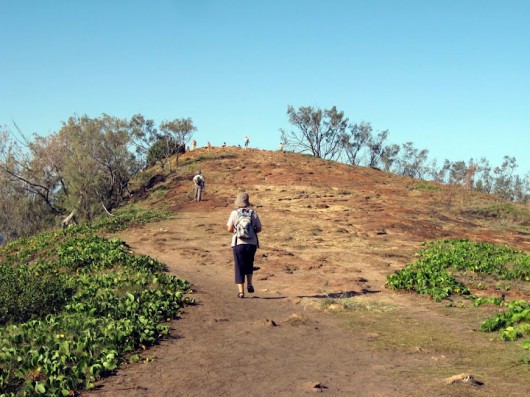 Indian Head degradation by excessive uncontrolled tourism.
Where are DERM Parks Management – off lighting grass fires?
. Indian Head degradation by excessive uncontrolled tourism.
Where are DERM Parks Management – off lighting grass fires?
.
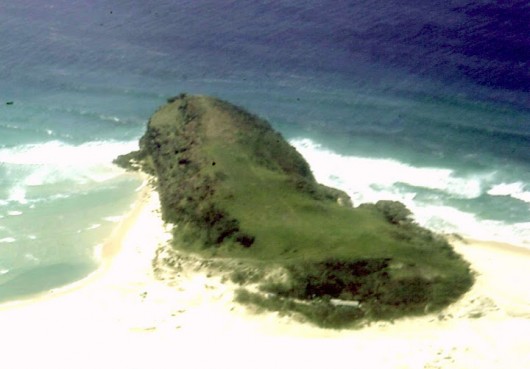 Indian Head vegetation back in 1974 Indian Head vegetation back in 1974
.
‘A disproportionate amount of the budget is spent on recreational facilities, visitor safety and management, waste management. Road widening and upgrading has become an obsession. This focus has led to the neglect of research and the natural resource management, — environmental monitoring of wildlife and ecosystems, fire management, weed control, and quarantine.’
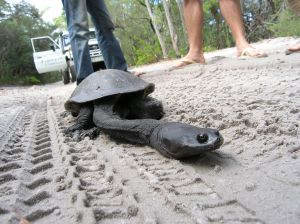 Fraser Island’s native long-necked turtles
vulnerable to 4WD hoons Fraser Island’s native long-necked turtles
vulnerable to 4WD hoons
.
‘The preoccupation with recreation management on Fraser Island is encouraging more and more visitors to visit Fraser Island in unsustainable ways. Recreation is degrading Fraser Island’s World Heritage values including its iconic lakes. Recreation management is at the expense of managing the island’s natural resources. These suffer from lack of adequate monitoring. No monitoring of the water quality in the lakes was done for a decade while road run-off continues to pour into the lakes impacting on water quality.’
 Ongoing sand dune damage by unmonitored 4WDs
Tourist access on Fraser Island has become a free-for-all ! Ongoing sand dune damage by unmonitored 4WDs
Tourist access on Fraser Island has become a free-for-all !
.
Fraser Island has less than one kilometre of boardwalks. Queensland government policy prevents any feasibility into developing an environmentally more sustainable light rail people mover there. Yet compared with Gunung Mulu National Park in Malaysia, listed eight years after Fraser Island, with exactly a tenth of the visitor number of Fraser Island puts Fraser Island management to shame.
[Source: ‘Queensland’s shameful management of the Fraser Island World Heritage site‘, by John Sinclair, 20100702, ^http://randomkaos.com/node/14, (John Sinclair is one of Australia’s leading nature conservationists and has lead the fight to save Fraser Island since 1971 when he founded the Fraser Island Defenders Organisation)]
.
In 2007 an Irish backpacker tourist, Evan Kelly, while on Fraser Island thought it was a good idea to run down a sand dune into Lake Wabby. He did this several times then landed head first in the lake, hurt his back then sued the Queensland Government and the backpacker hostel, Pippies Beach House, for failing to warn him of the dangers.
Previously in 2006, tourist Su Chul Jang from South Korea, decided to run down a sand dune and dive into Lake Wabby, but became a quadriplegic and sued the tour company Fraser Escape 4×4 Tours Pty Ltd and the Queensland Government.
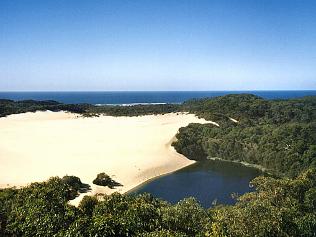 Leave Lake Wabby alone! Leave Lake Wabby alone!
.
[Source: Fraser Island backpacker sues Queensland Government, tourism operators for injuries at Lake Wabby’ by Kay Dibben, The Sunday Mail (Qld), 20100829, ^http://www.couriermail.com.au/news/queensland/fraser-island-backpacker-sues-queensland-government-tourism-operators-for-injuries-at-lake-wabby/story-e6freoof-1225911278600]
.
What’s the full cost of Fraser Island tourism?
.
The Queensland Government’s World Heritage management of Fraser Island has been called into question internationally over claimed incompetence and malice.
Opposition Shadow Sustainability Minister Glen Elmes said he had “taken steps to ensure that UNESCO, the organisation charged with overseeing World Heritage listed areas, has been advised of the island’s plight”. He described island management as “incompetent at best” and a betrayal of state government conservation obligations.
Mr Elmes accused her Department of Environment and Resource Management of a major cover-up of mismanagement, environmental damage and “ruthless and cruel” policies on dingo management. Mr Elmes told Parliament this week that he had read the report, estimating the death of 97 dingoes from causes listed in autopsy reports as “lethal injection, shot, run over, poisoned, starvation and others”.
“One autopsy lists under possible cause of death, ‘rifle-itis,’ while another states ‘half an ounce of hot lead,” he said. “Labor’s interim report shows happy snaps of a dingo family, dingoes on the beach, dingoes frolicking in the water, a dingo running up the beach with a fish in its mouth. “On a normal day, those dingoes would be hazed by rangers – that is shot with a clay pellet, moving them away from the beach and away from their main food source,” he said.
[Source: Claims of Fraser Island ‘cover-up’ by Arthur Gorrie, 20100902, ^http://www.gympietimes.com.au/story/2010/09/02/Fraser-Island-cover-up-claimed/]
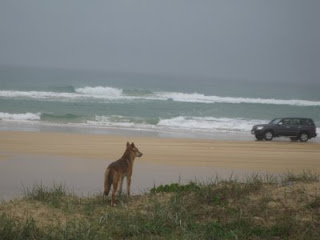
.
Meanwhile the Queensland Labor Government’s only interest for Fraser Island is more tourism development.
In September 2010, Federal Labor Environment Minister Tony Burke and Queensland’s Bligh Labor Government’s Climate Change and Sustainability Minister Kate Jones opened a joint $3.4 million tourist facilities at Lake McKenzie on Fraser Island.
.
“This is great for tourism on the island and great news for the Hervey Bay economy.”
~ Kate Jones’ 20th Century mindset for world heritage.
.
Labelling it “eco-friendly”, the modern facilities include:
- More vehicle access routes
- A bigger car park
- Wider pedestrian access to the beach
- More toilets
- More viewing platforms
- Improved signage
- Oh and extensive site revegetation. Nice.
.
[Source: ‘Ministers officially open major upgrade to facilities at Lake McKenzie’ (Labor joint media release), 20100923, ^http://www.environment.gov.au/minister/burke/2010/mr20100923.html]
.
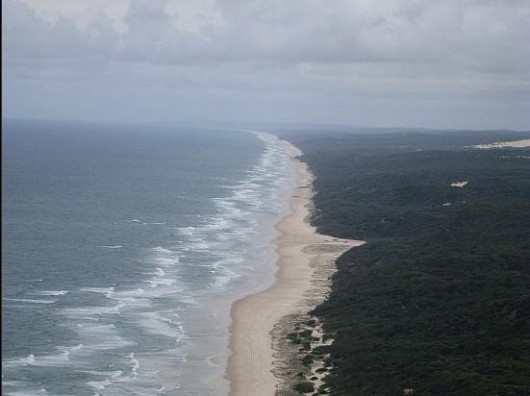 Fraser Island’s 75 Mile Beach
…clear of ferals of all types Fraser Island’s 75 Mile Beach
…clear of ferals of all types
.
It is time to place Fraser Island on the World Heritage in Danger List, get all the ferals including the tourists and their profiteers off the island and to commence the job and investment of serious World Heritage management of one of the planet’s remaining important nature assets.
.
Tigerquoll
Suggan Buggan
Snowy River Region
Victoria 3885
Australia
 Lake Boomanjin on Fraser Island,
Supposedly protected
(Photo by Steven Nowakowski, click photo to enlarge) Lake Boomanjin on Fraser Island,
Supposedly protected
(Photo by Steven Nowakowski, click photo to enlarge)
.
Further Reading:
.
[1] ‘ Queensland’s shameful management of the Fraser Island World Heritage site‘, by John Sinclair, 20100702, ^ http://randomkaos.com/node/14, (John Sinclair is one of Australia’s leading nature conservationists, has lead the fight to save Fraser Island since 1971 when he founded the Fraser Island Defenders Organisation).
.
[2] ‘ Fighting Ferals on Fraser Island‘, by Fraser Island Defenders Organization (FIDO) “The Watchdog of Fraser Island”, aims to ensure the wisest use of Fraser Island’s natural resources, ^ http://www.fido.org.au/education/FightingFerals.html
.
Friday, February 17th, 2012
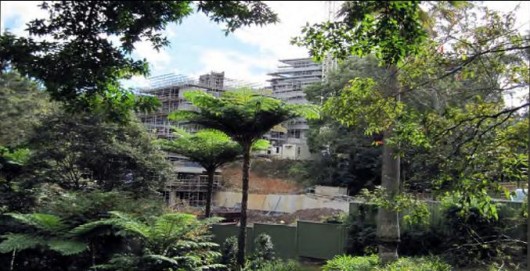 The disappearing urban forest of Ku-ring-gai, Sydney’s North Shore
Biodiversity-linkages within Urban Forest are provided by
connecting gardens, street trees, golf courses, ovals and parks. The disappearing urban forest of Ku-ring-gai, Sydney’s North Shore
Biodiversity-linkages within Urban Forest are provided by
connecting gardens, street trees, golf courses, ovals and parks.
All link together with surrounding protected reserves
to form corridors and habitat for remaining urban wild-life…..
.
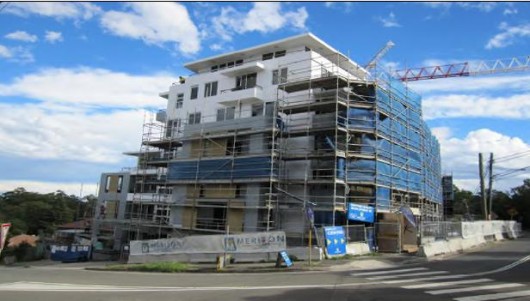 …however improper zoning allows biodiversity linkages to be lost
when land area and soils are cumulatively removed. …however improper zoning allows biodiversity linkages to be lost
when land area and soils are cumulatively removed.
By this process the regenerative capacity of native and nonnative Urban Forest vegetation
is displaced forever.
.
~ J. Harwood
.
Ku-ring-gai….’a community under the canopy’
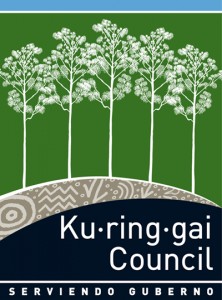
It is often said that the Ku-ring-gai community lives ‘under the canopy‘ because of the three large national parks and multitude of natural spaces in our local government area. To illustrate this idea, the Ku-ring-gai Council logo features a grouping of Sydney Blue Gums – a native tree prominent in the local landscape.
The five trees represent the five wards – Gordon, St Ives, Comenarra, Roseville and Wahroonga. The green typifies the Sydney Blue Gum and the band of blue above it depicts the bright sunlit sky which is visible through the swaying tree canopies.
The light brown graphic element below the trees acknowledges the area’s Aboriginal heritage. It includes indigenous symbols for a campsite, mountains, kangaroo, boomerang and emu provided by Aboriginal artist Nikki McCarthy. It also includes a pair of stingrays found in an Aboriginal rock carving in Ku-ring-gai Chase National Park, used in the logo to represent the Guringai people, sometimes known as ‘the stingray people’.
The black area at the bottom of the logo represents the understorey of the Sydney Blue Gum Forest as well as providing an important link to the traditional owners of the land by taking the same meaning as in the Aboriginal flag, with the black representing Aboriginal people.
The Ku-ring-gai Council motto, ‘serviendo guberno’, means ‘I govern by serving’ and has been used by Council since 1928. It is included in the logo to reaffirm Council’s fundamental commitment to serving the community.
[Source: Ku-ring-gai Council, ^http://www.kmc.nsw.gov.au/www/html/1881-council-logo.asp]
.
What is so special about Ku-ring-gai?
Ku-run-gai is an elevated region mostly wet sclerophyll forest ecology of high conservation value, including the endemic Blue Gum High Forest. The region is coming under relentless destruction for housing development and so its natural values are steadily disappearing.
‘Ku-ring-gai‘ derives its namesake from Mount Ku-ring-gai, a ridgeline about 200m above sea level, located about 30km north of the Sydney CBD. Apart from the ridgeline along which the Pacific Highway was built, Mount Kuring-gai consists of steep, heavily wooded hills and gorges. The water drains to the west into Berowra Creek and on the east into Cowan Creek. Both these waterways empty into the Hawkesbury River system. The area receives high rainfall, and its slopes fall steeply towards national parks on three sides – Lane Cove, Garigal and Ku-ring-gai Chase. Other natural features of Ku-ring-gai are its tree canopy (including important remnant Blue Gum High Forest, its wild life, its watercourses and its readily erodable soils.
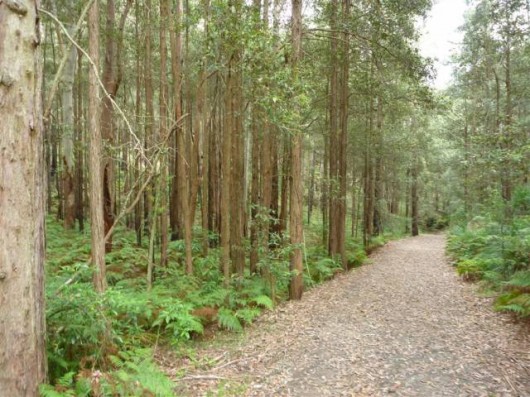 Blue Gum High Forest
Nearby Berowra Valley Regional Park
[Source: ^http://www.wildwalks.com/bushwalking-and-hiking-in-nsw/berowra-valley-regional-park/blue-gum-walk-joe-s-mountain-circuit.html]
Blue Gum High Forest
Nearby Berowra Valley Regional Park
[Source: ^http://www.wildwalks.com/bushwalking-and-hiking-in-nsw/berowra-valley-regional-park/blue-gum-walk-joe-s-mountain-circuit.html]
.
The Guringai Aboriginal people originally inhabited the area between the coast and Berowra Creek. Urgent changes are needed to the New South Wales Planning Act in order to prevent the loss of biodiversity and critical habitat and to consider the cumulative impacts in our future cities. ‘Ku-ring-gai‘ was an Aboriginal word describing the home or hunting ground of the local people, so this is possibly the origin of the name. Another suggested explanation for the name, that is now considered incorrect, was that kuringai was a combination of the words kuri, meaning ‘black duck’ and ngai, meaning ‘self’ (supposedly local people referring to themselves as black).
The township was called Kuring-gai from 1892, but the suburb’s name was changed to Mount Kuring-gai in 1933. The Shire of Ku-ring-gai was first constituted with six councillors in March 1906. Almost all of Ku-ring-gai was designated for residential development as opposed to commercial and industrial developments, and very few blocks of flats were permitted before 1940.
Ku-ring-gai is now engulfed within an encroaching suburbia locally branded as Sydney’s North Shore. The Ku-ring-gai Shire encompasses the suburbs of Roseville, Lindfield, Killara, Gordon, Pymble, Turramurra, Warrawee and Wahroonga, straddling the ridge that carries the railway from North Sydney to Hornsby; and St Ives, straddling Mona Vale Road as it heads towards the coast.
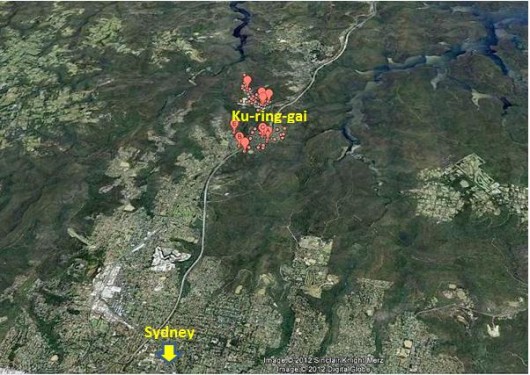 The relative position of Ku-ring-gai
on the northern outer tentacles of Sydney Metro sprawl
(Google Maps, 2012)
. The relative position of Ku-ring-gai
on the northern outer tentacles of Sydney Metro sprawl
(Google Maps, 2012)
.
Ku-ring-gai’s situation represents an example of insatiable corporate land use development being allowed to run roughshod over ecological values. Forested areas are being bulldozed, destroying remnant and critical corridors for flora and fauna. Ku-ring-gai contains urban forests of important biodiversity, yet regional government planning is being corrupted by wealthy developers and their wealthy lawyers to change laws to allow the bulldozers in. Remnant forest by remnant forest is being supplanted by high rise. The cumulative impacts on these critical habitats are un-reported tragedies.
[Sources: 2. ‘Mount Kuring-gai’, by Joan Rowland, 2011, in ‘Dictionary of Sydney’, Dictionary of Sydney Trust,^http://www.dictionaryofsydney.org/entry/mount_kuring-gai , 2. Ku-ring-gai Historical Society, 1996, ‘Focus on Ku-ring-gai: The Story of Ku-ring-gai”s Growth and Development’, ^http://www.kmc.nsw.gov.au/www/html/169-history-of-ku-ring-gai-council.asp ]
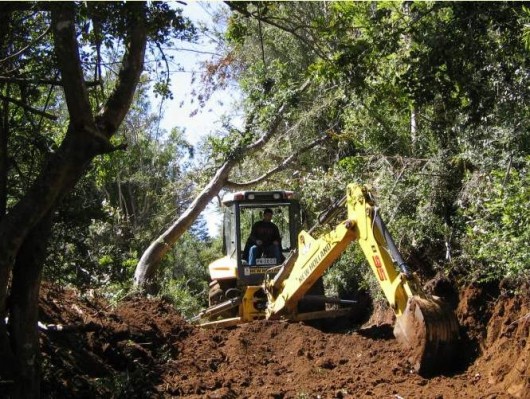 . .
Ku-ring-gai’s built heritage
..
Ku-ring-gai’s built heritage features some of the best in NSW – twenty-seven precincts were recommended by the National Trust in 1997 as Urban Conservation Areas. They include not only fine examples of Federation and Inter-war architecture, but many of these precincts display an overall quality and consistency that mark them out as being of State and National heritage significance.
.
Case in Point: ‘Tulkiyan House Museum’
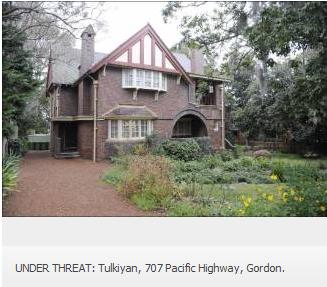
Built in 1913, Tulkiyan is an important example of the work of Bertrand J Waterhouse, a prominent Sydney architect. In Federations arts and crafts style, it displays asymmetrical, dominant gables; shingled roof and wall finishes; and bay windows. The interior includes elaborate plaster ceilings, Art Nouveau style gas fireplaces and built-in cupboards – an innovation at the time.
The Donaldson family lived in the house continuously for over 80 years from 1913, during which the original style was maintained. The home and its contents provide an insight into upper middle class life in Sydney during the first half of the 20th century.’
[Source: ‘Tulkiyan House Museum’, Ku-ring-gai Council, ^http://www.kmc.nsw.gov.au/www/html/1369-tulkiyan-house-museum.asp]
.
‘2009: Ku-ring-gai’s built heritage comes under threat of high rise’
[Source: ‘National Trust warns on Ku-ring-gai Planning Panel plan’, 20090814, by Katrina Adamski, North Shore Times, ^http://north-shore-times.whereilive.com.au/news/story/high-density-plans-ripping/]
.
THE heart of Ku-ring-gai is being ripped out with the possible demolition of 692 heritage homes.
This is the view of the National Trust, which has taken a stance against the Ku-ring-gai Planning Panel’s proposals to build medium- to high-density development in the area’s six town centres.
The trust’s core programs director Scott Woodcock said its members were trying to protect the natural and cultural heritage of Ku-ring-gai.
“The scale and magnitude of the threat to heritage buildings is unprecedented,” Mr Woodcock said. “The outrage is still prevalent in the community following the public meeting attended by 1000 people and more than 1800 submissions were received.
“At the National Trust, we are still receiving calls every day about what they can do to stop the Planning Minister (Kristina Keneally) from gazetting the plans. People have also been calling for us to organise a rally but we would prefer to speak to the minister first.”
 Kelly and Keneally
Pro-development NSW Labor planning ministers of yore
Sydney growthist lobby mantra – “Sydney must grow!” Kelly and Keneally
Pro-development NSW Labor planning ministers of yore
Sydney growthist lobby mantra – “Sydney must grow!”
.
Heritage buildings under threat of demolition in National Trust conservation areas include 1 Maclaurin Pde, Roseville; the Spanish mission-style church, 1186 Pacific Highway, Pymble; Tulkiyan 707 Pacific Highway, Gordon; and 2 Victoria St, Roseville.
The former Gordon home of Harbour Bridge designer John Bradfield could also be bulldozed under the proposal. Mr Woodcock said people were rightly concerned about losing their homes or having a six-storey development built next door to them.
“The spectacular P&O-style house at 1 Maclaurin Parade is not on the council’s heritage list or in a council conservation area,” he said. “It is within the trust’s urban conservation area, but even if it was individually saved, it would be surrounded by high-rise. The church and Tulkiyan are listed by the council, but even if they were kept they could be surrounded by high-rise which would destroy their curtilage. Practically the whole of Victoria St, Roseville, is under threat between Hill St and Spearman St. Only the school isn’t zoned for higher density’”
But Planning Minister Kristina Keneally said there was “no requirement” for the 700 heritage homes to be demolished. “The plan actually introduces heritage conservation zones,’’ Ms Keneally said. “In fact, the Bradfield house is proposed for heritage listing under the plan put forward to the department. “It is important to remember that these are people’s homes. It is up to an individual home owner as to what they do with their property.’‘
The minister said the government was identifying places, particularly around rail lines, where increased density and a different housing type could be accommodated.
Ms Keneally said only 6% of Ku-ring-gai was covered by the town centres plan.
.
Keneally in 2009 : “Sydney will grow and it will change …
it is projected to reach a population of about 6 million by 2036,
up by about 1.7 million people from 2006.”
.
But Opposition Leader Barry O’Farrell said almost 80% of Ku-ring-gai urban conservation areas would be destroyed under the State Government’s planning proposals. Mr O’Farrell said the National Trust report confirmed Labor’s statewide attack on heritage conservation.
“(Premier) Nathan Rees and (Planning Minister) Kristina Keneally are the Bonnie and Clyde of NSW, stealing the heritage heart out of the state,’’ he said. “These decisions are borne out of the inherent conflict of interest of a minister also being responsible for preservation of heritage items.’‘
He said the National Trust report was as close as you could get to a respected, independent umpire giving Labor a capital F for fail for its “lousy heritage credentials’”.
He said the NSW Liberal/Nationals had already committed, when in office, to appoint a separate heritage minister.
.
Local Reader’s Comments:
.
Denise Hendy writes (20090820):
.
“The ‘planning committee’ meeting at UTS was an insult to our intelligence. It was a total farce from a bulldozer panel committed to wrecking Ku-ring-gai’s leafy outlook. I have recently rejoined the National Trust because I feel they need support from locals to keep this Government on track.
I can’t believe the State Government is allowing our heritage to be torn down. Australia is a young country and has little heritage to show. Obviously these people have never been to visit old communites overseas to see the beauty and wonder of heritage which is important for younger generations to see and realise our history.”.
.
Graham Bode writes (20090815):
.
“Undoubtably it is a serious problem and with this government having two years to run it is just not going to get better. The government or its planning advisers have a view of Sydney as being something different to what it really is.
We should grow from where we are and where we have come from. Unfortunately neither the council or the state opposition are in the position to achieve a better outcome, to change the planning strategy.
As a writer to Saturday’s Sydney Morning Herald suggested a more vigorous but peaceful approach is required. Perhaps being a nuisance to the government and vigorous protesting may be the only options left open to us.”
.
The following article below ‘Mayday for Urban Forests‘ was contributed by Janet Harwood of the local community group ‘Friends of Ku-ring-gai Environment Inc.’ (FOKE)
.
Friends of Ku-ring-gai Environment

‘FOKE is a community group with membership drawn from across Ku-ring-gai, opposing inappropriate and unsympathetic overdevelopment within Ku-ring-gai, and defending and promoting the cultural and natural heritage of Ku-ring-gai.
‘FOKE is not anti-development. We work on behalf of residents and friends for the maintenance of Ku-ring-gai’s heritage and the enhancement of the existing traditional character and amenity of its environment, both built and natural.’
FOKE, PO Box 403, Killara, 2071, ^www.foke.org.au
.
‘Mayday for Urban Forests’
by Janet Harwood, FOKE (June 2011)
.
Urgent changes are needed to the New South Wales Planning Act in order to prevent the loss of biodiversity and critical habitat and to consider the cumulative impacts in our future cities. Biodiversity is critical infrastructure – the basis of life. Urban Forests and natural habitat remnants are the last biodiversity hotspots in cities. They are increasingly critical flora and fauna corridors. The significance of biodiversity to humans is greater than is understood. As humans seek health, well being and survival in future cities, cumulative impacts on these critical habitats are un-reported tragedies.
We are in ‘the urban age‘. The United Nations reports that more than half the world’s population lives in urban areas since 2007. (1) By 2050 it will be 70%. Australia’s urbanisation is higher. Scientists have long known human physical and mental health and well being depends on biodiversity. (2) As biodiversity decreases, human choices for survival shrink. (3) Scientists say its irreversibility makes biodiversity loss the most important issue faced by humanity (Dale and Hill 1996). Biodiversity loss is the most significant environmental problem facing Australia (Lindenmayer, “On Borrowed Time” 2007).
In his book ‘Collapse’ Diamond notes that removal of forests, and subsequent ‘landscape amnesia‘ and ‘creeping normalcy‘, play major roles in collapse of societies. (4) He points to policy makers for failure to perceive the problem of forest removal.
.
What is an ‘Urban Forest’?
.
An ‘Urban Forest‘ is existing biodiversity in protected reserves, as well as connected, but unprotected, native and non-native vegetation corridors in golf courses, public parks, ovals, residential streets and private gardens. Especially in environmentally sensitive areas, all linked natural habitat remnants, important seed-bank and sensitive soils, together, form part of precious Urban Forest.
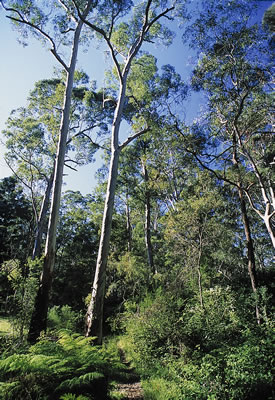 ‘Blue Gum High Forest’
in and around Ku-ring-gai ‘Blue Gum High Forest’
in and around Ku-ring-gai
.
Rare, urban biodiversity still exists in listed critically endangered ecological communities, part of Urban Forest within thirty rail minutes of the Sydney GPO – but for how long?
Urban Forest in Sydney occurs most densely in the north, north west of Sydney and also in southern and western Sydney. Rapid urbanization means biodiversity in the un-protected part of Urban Forest is vulnerable to zoning for development.
Due to the importance of biodiversity to human health in future cities, Urban Forest needs urgent protection, through legislation. (Ed: Biodiversity is also important for its own existence rights, beyond anthropocentric benefit).
Today, lands most desirable to protect have become the lands most likely to be developed. The word “biodiversity” appears seldom, if at all, in land-use planning policy platforms and legislation governing the planning of city futures. (5)
The absence of specific protective zoning for Urban Forest potentially means the application of ‘inner-city zoning‘ in unique ‘Environmentally Sensitive Areas‘ (ESAs). Unless urgent steps are taken for intergenerational equity in planning legislation including giving protection to Urban Forest by specific zoning, and requiring consideration of the cumulative impacts in zoning for development, we will almost certainly not have Urban Forest in the future.…however improper zoning allows biodiversity linkages to be lost when land area and soils are cumulatively removed.
By this process the regenerative capacity of native and non-native Urban Forest vegetation is displaced forever.
.
How do we know Urban Forest is disappearing?
.
Trees prevent development and their absence facilitates it. Cascading environmental damage commences at, or before, the point of zoning for development. Since each zoning and each development is assessed on its own, the un-assessed cumulative impact of zoning for development quickly turns an environmentally sensitive area (ESA) into a construction zone.
Zoning is the most profitable point in the development process. Zoning is also when the greatest damage is done to the environment.
‘Tree Preservation Orders‘ (TPOs) are of little value. Trees die mysteriously and are easily removed. Tree removal proliferates in dense, rare Urban Forest. Reliable tree record and protection of significant trees by local councils is lost. The domino effect of acquisition of properties for development, during zoning, is an insidious process. Most locals do not know when and where houses are acquired for development, which rapidly tears neighbours and neighbourhoods apart. (6)
As newer residents replace long-standing ones, ‘landscape amnesia‘ and ‘creeping normalcy‘ take over, and the once rich Urban Forest becomes an urban myth. Wildlife populations plummet and without habitat, urban biodiversity quickly disappears.
As the cumulative impacts of zoning increase and population pressures rise, tree removal gathers momentum. Golf courses, churches, schools and other institutions responding to these expansion pressures find the need to remove not one or two trees, but tens and hundreds of trees. This is in addition to tree removals by developers and individuals.
After development has occurred, the hundreds of saplings replanted in the remaining soils cannot replace habitat provided by foliage, branches and hollows of mature trees in an Urban Forest. In this way, environmentally uninformed decision making and cumulative zoning quickly destroys efforts, by council staff in the field and volunteers, to protect and restore biodiversity.
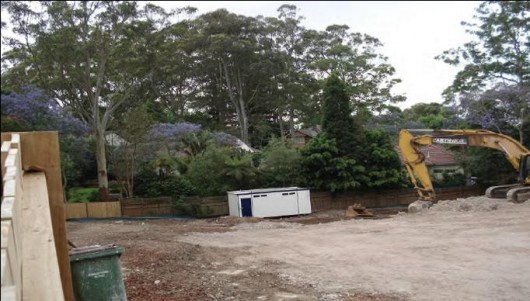 As sites are cumulatively cleared, the very basis for fragile Urban Forest
(i.e. rich soils and seed-bank)
is being excavated and removed forever by Improper Planning. As sites are cumulatively cleared, the very basis for fragile Urban Forest
(i.e. rich soils and seed-bank)
is being excavated and removed forever by Improper Planning.
.
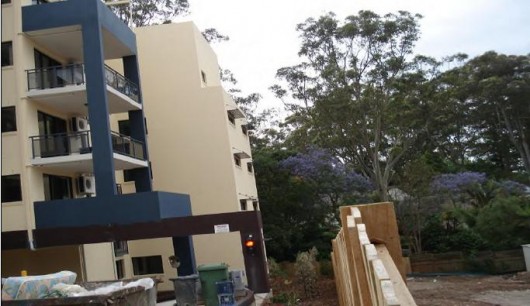 Replacement building side set-backs leave no room for tall canopy trees,
which once formed bio-links.
Improper Zoning permits a footprint totally inappropriate
for an Environmentally Sensitive Area (ESA) Replacement building side set-backs leave no room for tall canopy trees,
which once formed bio-links.
Improper Zoning permits a footprint totally inappropriate
for an Environmentally Sensitive Area (ESA)
.
The problem lies in the overarching power of land use planning legislation.
.
State (TSC Act)* and national (EPBC Act)* environmental legislation has failed to prevent biodiversity loss in NSW. The dominance of an ecologically un-informed NSW planning system, corrupted by failures, faults and flaws in that system, forces unreasonable concessions from environmental departments and regulatory bodies, resulting in irreparable biodiversity loss. (7).
The NSW planning system can implement zoning with negative impact where “critical habitat” provisions are not applied. Further, cumulative removal of vegetation and regenerative capacities (land area and soils) of Urban Forest is not assessed in land-use planning. A scientific study of cumulative impacts says, “while each single land use change results in a negligible impact, the accumulation of these individual changes over time and within a landscape or region may constitute a major impact.” (8) Neither state nor federal legislation considers the destructive effect of many zonings overlaying each other.
The NSW Government’s Standard Local Environment Plan (LEP) (Ed: bureaucratic one-size fits all planning) is full of unknown perils for an area of high biodiversity. Its ‘Standard Zoning‘ approach certainly will allow smaller blocks of land within the range of Urban Forest. It will allow more development in the very soils needing more protection, to maintain current biodiversity levels in irreplaceable Urban Forests. (9).

.
Urban Forest has far greater long term economic value than construction, which excavates and trucks away the very basis of fragile flora and fauna habitats – environmentally sensitive soils.
That the resulting real estate is now being sold overseas and to investors – makes zoning for development, in areas of rare Urban Forest, a highly questionable process.
.
The NSW planning system appears un-aware of the intrinsic value of, and the method and need for, protecting land for its delicate biodiversity. Clearly, a lack of understanding of the value of biodiversity is demonstrated by the nature and number of zonings allowed in environmentally sensitive areas (ESAs).
.
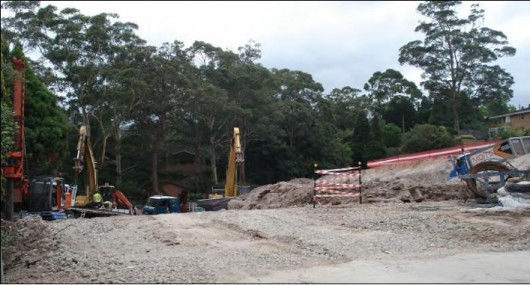 Blue Gum High Forest site damaged by “moonscaping” unassessed under one LEP.
Damage from an adjacent development is cumulatively allowed under another LEP. Blue Gum High Forest site damaged by “moonscaping” unassessed under one LEP.
Damage from an adjacent development is cumulatively allowed under another LEP.
.
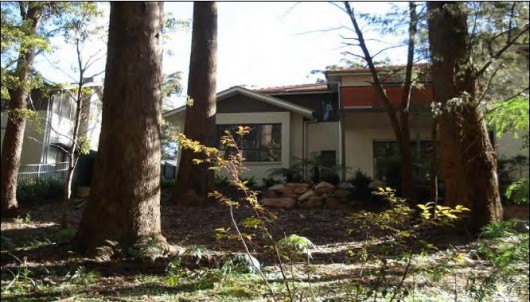 Building too close to established trees is the result of urban densification in Urban Forest.
The cumulative impact of inappropriate zoning is further tree removal. Building too close to established trees is the result of urban densification in Urban Forest.
The cumulative impact of inappropriate zoning is further tree removal.
.
Zoning for development is an un-recognized key threatening process for threatened species. The Planning legislation (EP & A Act)* genuinely fails to protect biodiversity. BioBanking (TSC Act) treats biodiversity protection as a financial transaction. The policy platform of the Planning Institute of Australia (PIA) fails to mention biodiversity. (10)
With little protection in legislation and policy, zonings for development have become key threats to rare, urban biodiversity.
In present land-use planning “sustainability” simply means catch-up, non-diverse sapling planting in remaining soils, after massive concrete footprints are made. Tellingly, a biodiversity strategy is not a gazetted instrument. It is not officially part of the land-use planning process, nor is it signed off by ministers, to precede the threatening process of zoning.
Media debate and public discourse of development in biodiversity rich areas. In the push to increase human population in Sydney’s North and North West, no media debate has been conducted regarding Urban Forest’s contribution to the Australian biodiversity pool in terms of the critically endangered ecological communities found in these areas. Yet Local Government Areas (LGAs) like Hornsby, Ku-ring-gai and Lane Cove are strategic wildlife corridors between national Parks. (11)
Examined in the media mainly in terms of dwelling numbers allocated and proposed, the unexamined attributes of Urban Forest are matters of national significance. A wealth of fauna and flora is being allowed to vanish now, from the creeping cumulative effects, of multiple zonings for development, on corridors of non-human habitat.
It is urgent to change land-use planning to protect precious urban biodiversity. Rather than displace our last Urban Forests, we should “bring forests into the cities”. (12)
City public lands, open-air carparks, railway corridors and vacant urban areas should be biodiversity refuges, community gardens and green spaces, to expand rare Urban Forest for human health. Local Council development planning directors are equipped to assess and report negative cumulative impact on Urban Forest. However, ecological qualification and direct responsibility, for biodiversity conservation and environment protection, are needed at director level. Policy makers and planners know that existing Urban Forest is easier to protect, than to re-forest. (13)
Urban Forests are crucial. In growing cities, once Urban Forests are removed and soils excavated, making amends is virtually impossible. Bio-links and rare urban biodiversity are of national importance and future job sources. The permanent loss of biodiversity (critical biological infrastructure) in Urban Forest is therefore a matter of national interest and security.
Storms, bushfires, droughts and flooding rains are removing flora and fauna habitats. (14)
Human development, inextricably tied to biodiversity, soils and Urban Forests, is also cumulatively removing the shared life support. (15)
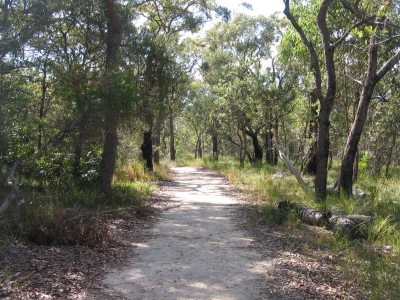 Mount Ku-ring-gai walking track Mount Ku-ring-gai walking track
.
Important Questions:
.
-
Why are Urban Forests being allowed to disappear?
-
Why are protective legislative provisions over-ridden?
-
Why is ‘critical habitat‘ not declared more rigorously?
-
Is biodiversity conservation a source of future employment?
-
Should Urban Forest areas be given a new category of protective rezoning?
.
by Janet Harwood, June 2011 (Edited).
janetsh@optusnet.com.au
‘Our Future is the Natural World’
.
* Abbreviations used above:
TSC Act: ‘The NSW Threatened Species Conservation Act 1995’
EPBC Act: ‘The Environment Protection and Biodiversity Conservation Act 1999, the Australian Government’s central environmental legislation’
EP & A Act: ‘The NSW Environmental Planning & Assessment Act 1979’
.
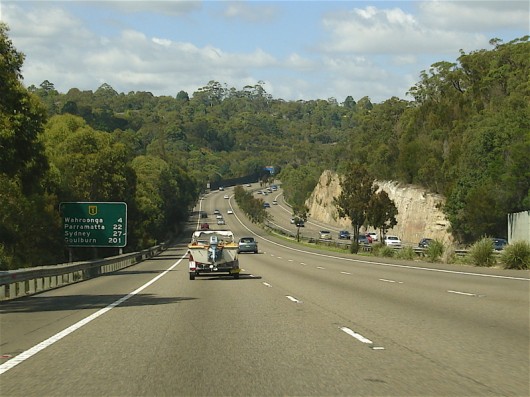 Six-lane freeway carved into Mount Ku-ring-gai Six-lane freeway carved into Mount Ku-ring-gai
.
‘Urban sprawl is ecological genocide – an inexcusable hate crime’
~ Editor
.
Notes and Further Reading:
.
1. UN-Habitat bi-annual State of World Cities report 2010, ^http://www.unhabitat.org/pmss/listItemDetails.aspx?publicationID=2917 (16mb)
(The United Nations Human Settlements Programme, UN-HABITAT, is the United Nations agency for human settlements. It is mandated by the UN General Assembly to promote socially and environmentally sustainable towns and cities with the goal of providing adequate shelter for all. Check website: ^http://www.unhabitat.org )
.
2. ‘Biodiversity Conservation: A Decision Making Context‘ (1996), book by Dr. Ann Dale and Prof. Stuart Hill
.
3. ‘Sustaining Life How Life depends on Biodiversity‘ (2008), book by Chivian E. and Bernstein A. (eds), Oxford University Press.
.
4. ‘Collapse How Societies Choose to Fail or Survive‘ (2005), book by Jared Diamond, Penguin Books.
.
5. See Policy platform of Planning Institute of Australia (PIA) and other urban projects and national urban policy.
.
6. See documentary film “State of Siege” in which activist film makers Dennis and Diane Grosvenor explore the destructive phenomenon of development and the politics behind it. ^http://www.imdb.com/title/tt0070959/
.
7. Standard Instrument (Local Environmental Plans) Order 2006, current version for 6 January 2012 to date, NSW Government legislation website, ^http://www.legislation.nsw.gov.au/maintop/view/inforce/epi+155+2006+cd+0+N
It is noted that NSW Environmental Zone protections available have failed to protect biodiversity and pressures from human development apply forcefully: when legislative provisions to declare “critical habitat” are not applied, where protective legislation is overridden; where cumulative impacts are not assessed; where systemic flaws and gaps continue to operate, biodiversity strategies are not given the status of gazetted instruments – and Departments of Environment are subsumed and/or not afforded the authorities they require, to genuinely protect biodiversity.
.
8. ‘Estimating the cumulative effects of development on wildlife habitat‘ (1998), book by David M. Theobald, James R. Miller and N. Thompson Hughes
.
9. ‘Environmental Baseline Study’ (2000), Ku-ring-gai Council website ^http://www.kmc.nsw.gov.au/www/html/212-research-studies-papers-and-reports.asp
.
10. Planning Institute of Australia website, ^http://www.planning.org.au/policy/policy-platform
.
11. Ku-ring-gai Council’s ‘Biodiversity Strategy‘, Appendix 6: Biodiversity Data, p.29, ^http://www.kmc.nsw.gov.au/resources/documents/Biodiversity_Strategy_May_2006_final_for_adoption1[1].pdf [>Read Document (1.1MB) ]
.
12. ‘Our Future is the Natural World‘, by J. Harwood, in a submission to ‘National Policy Unit Our Cities: Building a Productive, Sustainable and Livable Future’ 2011
.
13. Food and Agricultural Organisation of the United Nations (FAO), ^http://www.fao.org/docrep/005/t1680e/T1680E01.htm “Planning is important because trees are very often considered as an afterthought once development has taken place, rather than being incorporated at the original design phase. An integrated approach implies the participation of many different organizations – local councils, municipal and national planning bodies, departments, etc. Systematic management entails regulated tree management; operations such as planting, pruning, and felling must all be conducted in an organized manner, at the appropriate time. This is certainly more theoretical than actual in most urban settlements (in developed as well as developing countries); it also implies a greater degree of control over, or at least information about, all trees on all land types than usually exists.”
The FAO experience in ‘Urban Forestry‘ clearly indicates that more action is needed to protect existing Urban Forests (as defined). Zoning for protection of Biodiversity in Urban Forests (as defined), urgently needs to be specifically instituted through Planning legislation (EP&A Act). Local biodiversity strategies (TSC Act) need to be properly signed off by ministers and gazetted. Only the powerful land-use planning legislation can ensure that “critical habitat” in Urban Forests is not lost. Protective zoning for Urban Forest(as defined) and the complicating and devastating effects of un-assessed cumulative environmental impacts need to be immediately considered in Planning Legislation (EP&A Act).
.
14. ‘The Future of the Wild Radical Conservation for a Crowded World‘ (2006) book by J. Adams, Beacon Press, Boston, USA.
.
15. The basis for natural terrestrial habitats – Fertile soils:
“An estimated four million bacterial species occur in a ton of fertile soil, comprising ten billion or so organisms to each gram of weight. Although invisible, the collectivity of these organisms in soils and elsewhere is vital to our continued existence. Similarly, while a few thousands of the millions of insect species in the world afflict us as pests and disease carriers, we depend on the rest for our very lives. If beneficial insects did not flourish, most of the land ecosystems of the world would collapse and a good part of humanity would perish with them…….. For many reasons, not least our own well being, we need to take care of the rest of life”
by E. O. Wilson Foreword in the book ‘Sustaining Life How Life depends on Biodiversity‘ by Chivian E. and Bernstein A. eds. (2008) for The United Nations Programme.
.
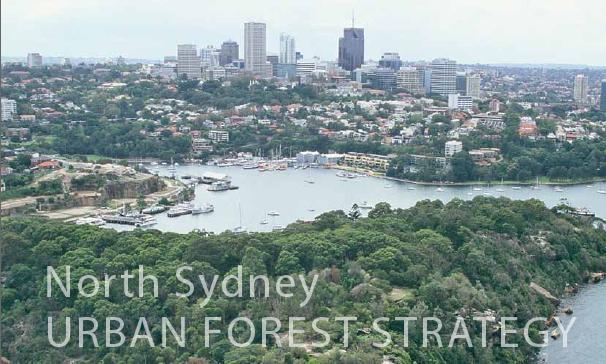 Urban Forest Strategy is a reality in nearby North Sydney Urban Forest Strategy is a reality in nearby North Sydney
.
Tags: biodiversity-linkage, Blue Gum High Forest, built heritage, creeping normalcy, critical habitat, Environmentally Sensitive Areas, FOKE, Friends of Ku-ring-gai Environment, Guringai Aboriginal, improper zoning, inner-city zoning, Ku-Ring-Gai, landscape amnesia, Mount Ku-ring-gai, overdevelopment, Standard Local Environment Plan, Standard Zoning, Sydney North Shore, the urban age, Tree Preservation Orders, Urban Conservation Areas, urban forest
Posted in Threats from Development | 1 Comment »
Add this post to Del.icio.us - Digg
|
|
 Tasmania’s Old Growth Forests
– victims of obsessive compulsive logging by Forestry Tasmania
(Photo courtesy of HVEC and Code Green)
Tasmania’s Old Growth Forests
– victims of obsessive compulsive logging by Forestry Tasmania
(Photo courtesy of HVEC and Code Green)



















































































